#Agent of Asgard issue 13
Text

(based off this post by @edenexxe)
#loki should be forced to live with multiple ghost form loki's who are trying to be his conscience and manage his morals#and he should rightfully ignore them most of the time#all things considered#Agent of Asgard issue 13
42 notes
·
View notes
Text


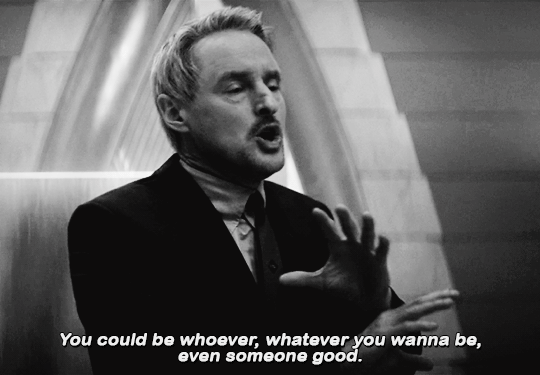
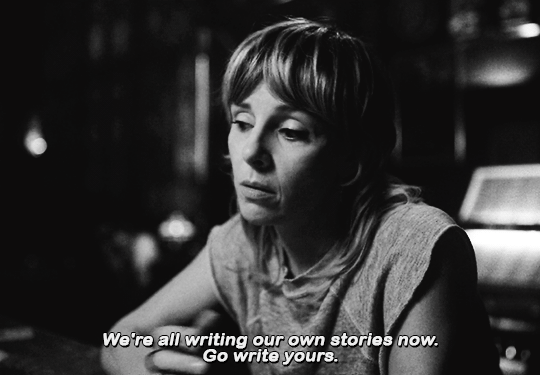

"I'm the God of Lies.
What's a lie, Verity? A lie is a story told. That's all. And we can rewrite our stories. All of us. Write our own happy endings. Our own redefinitions. We don't have to be what we're told to be. Even by ourselves.
I'M THE GOD OF STORIES"
– Agent of Asgard, Issue #13
#loki#loki laufeyson#loki series#agent of asgard#lokiedit#marveledit#dailyloki#loki spoilers#tom hiddleston#my gifs#I CANT BELIEVE IT 😭😭😭 GOD OF STORIES MY BELOVED#:') im fine
887 notes
·
View notes
Text
My favorite bard characters
The new Dungeons and Dragons: Honor Among Thieves movie and The Witcher has popularized the fantasy character class of bard.
A bard, in fantasy settings and historically, was usually a storyteller, or a minstrel who would tell stories in song. In fantasy settings they are usually minstrels. In Nordic culture a skald was the term for a storyteller (usually a highly creative and very prized slave).

Here is a top ten list of my favorite fictional bards.
13. Bonus: Loki: I'll start with number 11. Bonus: Loki. There is a viking skald in Loki: Agent of Asgard that is revealed to be Loki in disguise. So Marvel's Loki goes on this list. Loki is believed in by Asatru people so this entry is specifically in regard to Marvel's Loki. He also gained the title "God of Stories."
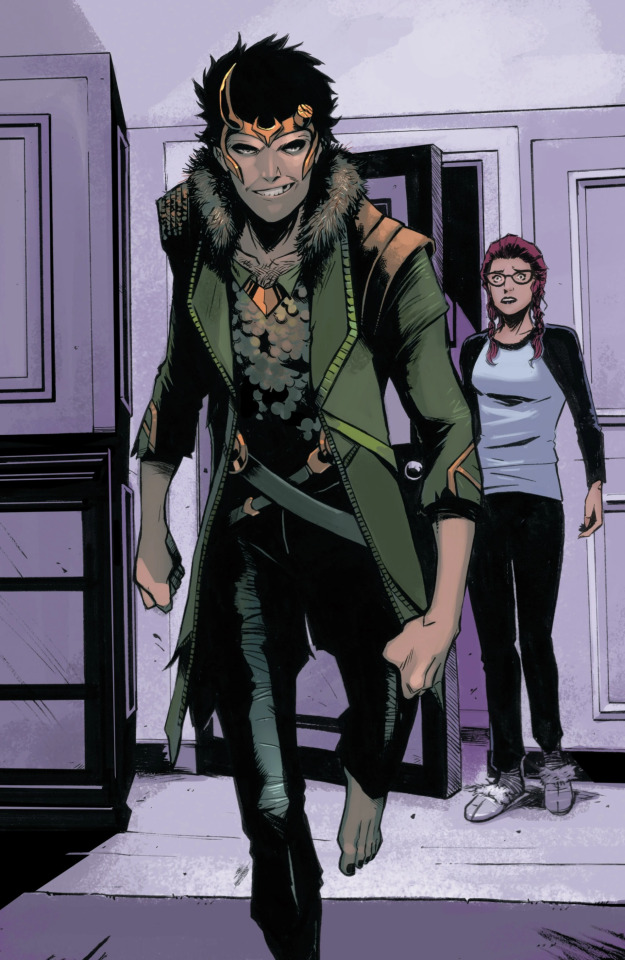
12. Morpheus AKA Dream of The Endless AKA The Sandman. Morpheus is The Lord of Dreams in Roman mythology and in Neil Gaiman's the Sandman . In The Sandman he is also known as The Prince of Stories.
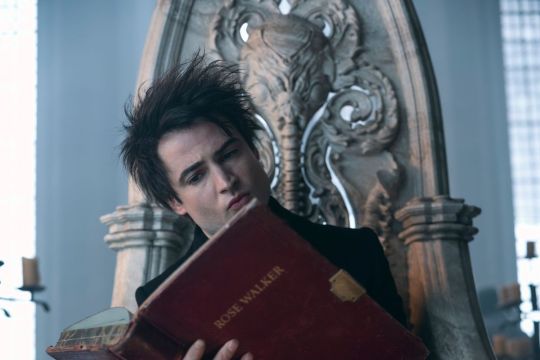
11. Lucien The Librarian and Cain and Abel from The Sandman by Neil Gaiman. Lucien was changed to Lucienne for The Sandman Netflix series but they're pretty much the same character. Lucien is the keeper of the largest library in the multiverse and was also the host of the horror anthology comics Tales of Ghost Castle. I'm sort of cheating a little here by mentioning Lucien and Cain and Abel since they're not actually bards but I love horror hosts.
Cain, Abel, Lucien, Eve (Raven Woman), Destiny (Destiny of The Endless), The Hecate (The Three Witches), and The Mad Mod Witch (The Fashion Thing) all started as horror hosts for DC's horror anthology comics. I'm reserving this spot for Lucien, Cain, and Abel. Hosts of Tales of Ghost Castle (which only ran for three issues), The House of Mystery (DC's oldest comic), and The House of Secrets (Spin-off of The House of Mystery and comic where we first get introduced to the concept of Swamp Thing).
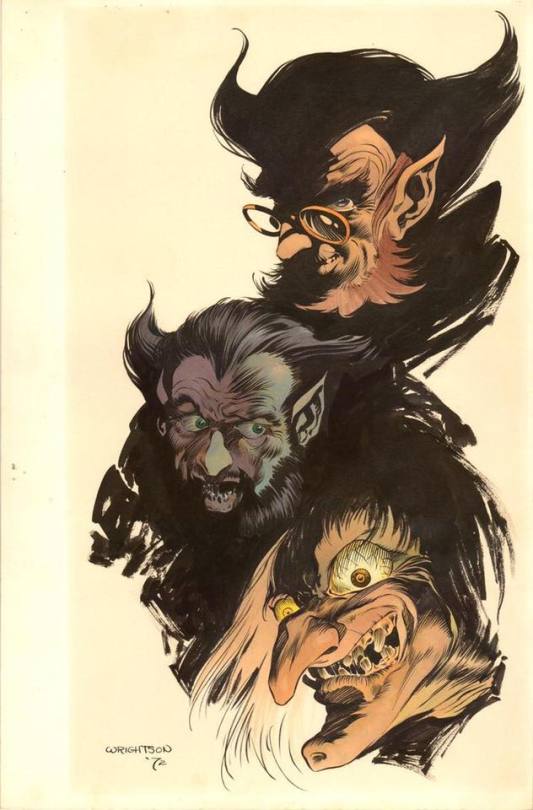
Before Neil Gaiman used these characters in The Sandman they told scary stories in DC's horror anthology comics which were DC's answer to EC's Horror anthology comics which brings us to...
10. The Crypt Keeper, Vault Keeper, and Old Witch. The Crypt Keeper hosted the Horror anthology comics Tales from the Crypt. The Vault keeper hosted Vault of Horror. And the Old Witch also told scary stories for EC comics. The Crypt Keeper hosted HBO's Tales From the Crypt TV series as well as Tales from the Cryptkeeper animated series. Season 2 of Tales from the Cryptkeeper was co-hosted by The Cryptkeeper, Vault Keeper, and Old Witch. They also collaborated as hosts for the joke book called Jokes from the Crypt. Again, I admit I am sort of cheating here by listing horror anthology hosts instead of actual bard characters so this is the last Horror anthology hosts for the list.
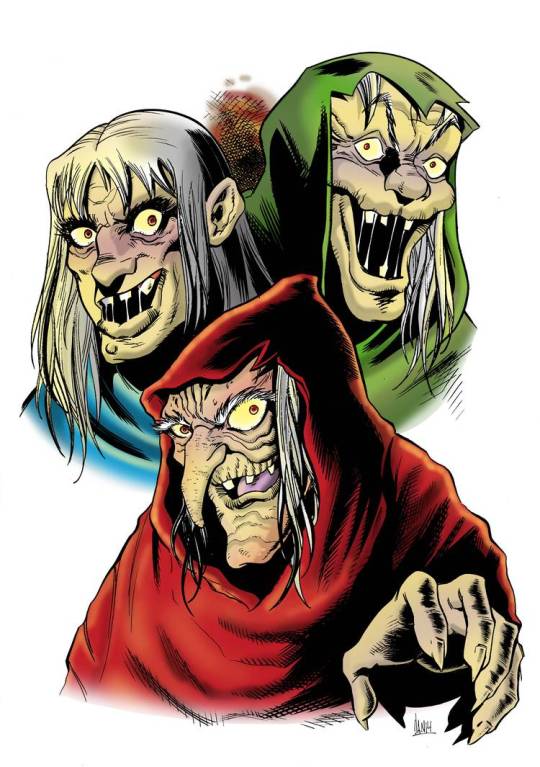
9. Peter Vincent in the 1985 film Fright Night, the 1988 film Fright Night: Part 2 and the Fright Night comic books. In Fright Night Peter Vincent is a has-been horror movie actor who now hosts a late night TV show where he shows his old movies.

Peter Vincent meets a teenage boy whose neighbor turns out to be a real vampire and Peter overcomes his own cowardice to become the hero he always pretended to be. Though Peter Vincent was originally just a stage name the character eventually embraces it to become a hero and protector of the innocent.
In the comic books Peter Vincent continued to host his late night horror movie TV series while working in secret to help Charley thwart the forces of evil. I consider Peter Vincent to be a contemporary bard character.
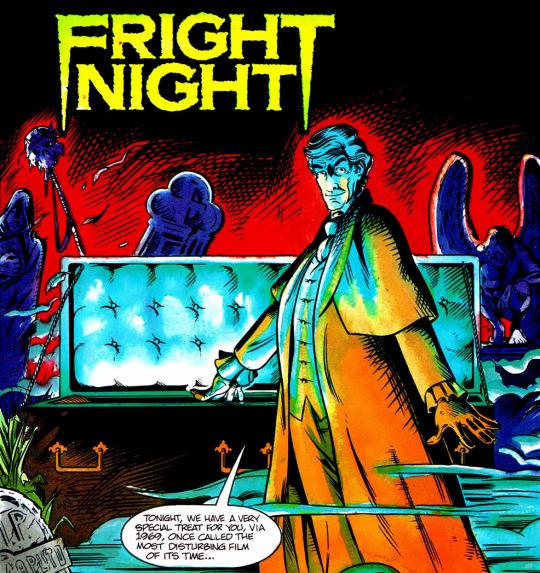
I would put Peter further on the list at number 3 perhaps but I left him at number 9 because he is an unconventional addition to this list.
8. Evyn AKA Shadow from the novel The King's Shadow.
Evyn wanted to be a bard but was mutilated in a brutal attack His tongue was cut out and he was left mute. His own uncle sold him into slavery. But thanks to fate's benign intervention Evyn was able to learn to read and write so he was able to become a storyteller as a scribe and eventually became an adopted son of the king.
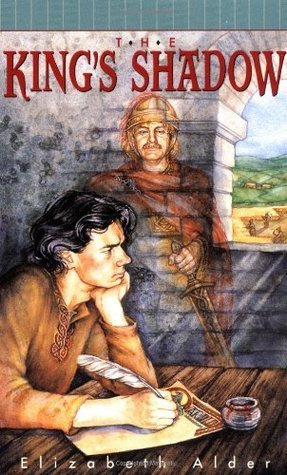
7. Gabrielle from Xena: Warrior Princess. Gabrielle was Xena's travel companion and very likely love interest (Lucy Lawless, the actress who played Xena) believed they were practically married in the end.
Xena: warrior Princess was the spin-off of Hercules the Legendary Journeys. I have often described The Witcher as being a gender inverted Xena: Warrior Princess.
Gabrielle was a novice bard who wanted to write about Xena's adventures and to eventually go on those adventures, herself.
Just as I sort of perfer Jaskier with longer hair, I actually liked when Gabrielle's hair was cut short later on in Xena.
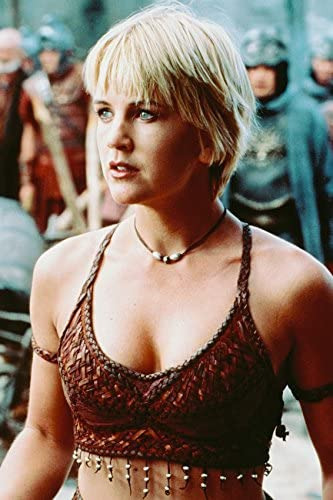
6. Essi Daven. I'm a little confused to if Priscilla (Callonetta) from the Witcher video games and Essi Daven from The Witcher novels are supposed to be the same character or not. Essi was from The Witcher novels. I suspect they are the same character but I've seen arguments that they are different enough that they count as separate characters.
But I have also seen people try to claim that Jaskier and Dandelion are different enough to count as different characters as well and Jaskier definitely is Dandelion. Dandelion was just what he was called in the English translations of the novels and in the English language video games.
Essi is a woman bard from The Witcher who was very much in love with Geralt though Dandelion (Jaskier) had feelings for her. Sadly she eventually died of smallpox. The burden of living in a medieval-esque society.
Dandelion was in love with her.

5. Priscilla AKA Callonetta is a woman bard from The Witcher video games. A rival and romantic interest to Dandelion (Jaskier). Possibly the same character as Essi Daven but some Witcher fans have argued that they are not the same character so I am listing them separately.
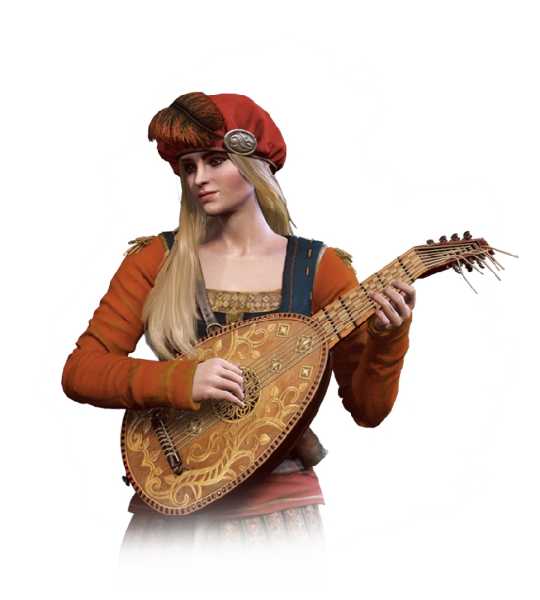
4. Edgin. Edgin is a character from Dungeons and Dragons: Honor Among thieves. In fact he is the main protagonist. He is a "Harper" that has fallen from grace. A Harper is a spy that poses as a bard to gain info and to stop criminals. So he is a bard but he used his status as a bard to work as a spy, hence the term "Harper."
Later he got a little greedy and it cost him dearly but he and his band of misfits set out on a quest to set things right.
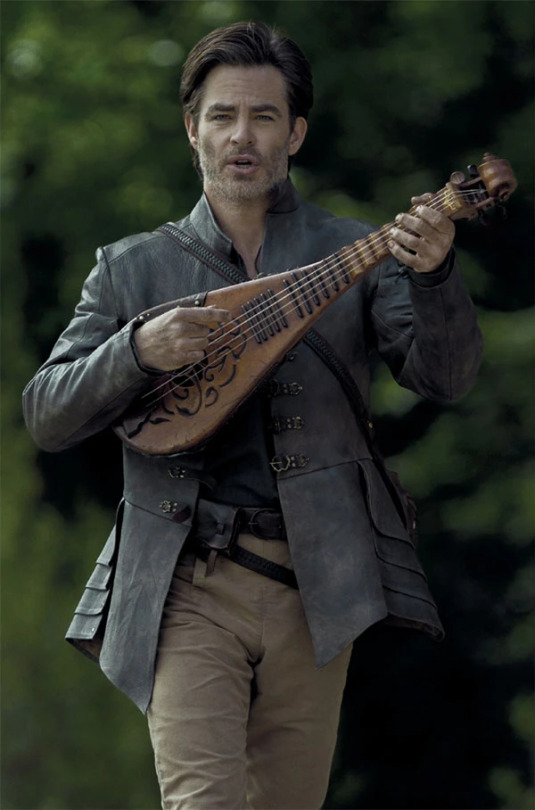
3. Fflewddur Fflam. I hate the character's name but love the character. The version in the Disney film The Black Cauldron is very different from the book character, including being much older, but I still found him to be an enjoyable character. He is a classic bard with a bit of a mysterious past.

In the books he's actually a king of a small kingdom but prefers life as a wandering bard. It makes him sound a bit like a role playing game character.
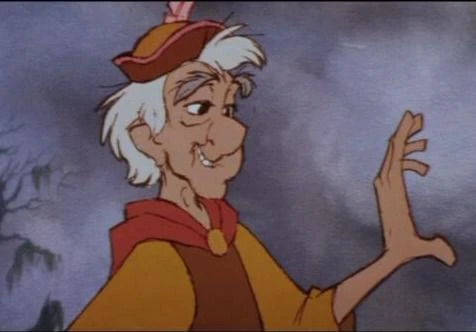
2. The Storyteller. This character's name is not actually given but he was a mysterious (possibly not entirely human) traveling storyteller, with a talking dog that appeared every week on Jim Henson's The Storyteller. He was portrayed by John Hurt and the dog was voiced by Brian Henson (Son of Jim Henson).
There was a spin-off called The Storyteller: Greek Myths.
John Hurt's portrayal of The Storyteller may have been why he was chosen to voice Morpheus AKA Dream of The Endless AKA The Sandman for a scrapped episode of Batman The Animated series.
Currently Neil Gaiman is involved with a revival of The Storyteller in development by the Henson company where he hopes to explore The Storyteller's own mysterious backstory.

1. Jaskier (Translates from Polish to Buttercup) / Dandelion.
Jaskier is the bard companion of Geralt of Rivia AKA The Witcher (Monster Hunter) from The Witcher novels, short stories, comics, Netflix series, and video games. In the English language versions of The Witcher novels and The Witcher video games he was known as Dandelion. But in The Witcher Netflix series and in the original Polish he was known as Jaskier which directly translates to Buttercup.

Whatever you call him, Jaskier is a great character. He is the companion of Geralt of Rivia in The Witcher and he is also his own well-developed character. By season 2 Jaskier had evolved from the slightly-conceited rock musician-esque bard into a compassionate freedom fighter who smuggled people to safety.
I absolutely love Joey Batey's portrayal of Jaskier as well as his incredible singing voice as the character.
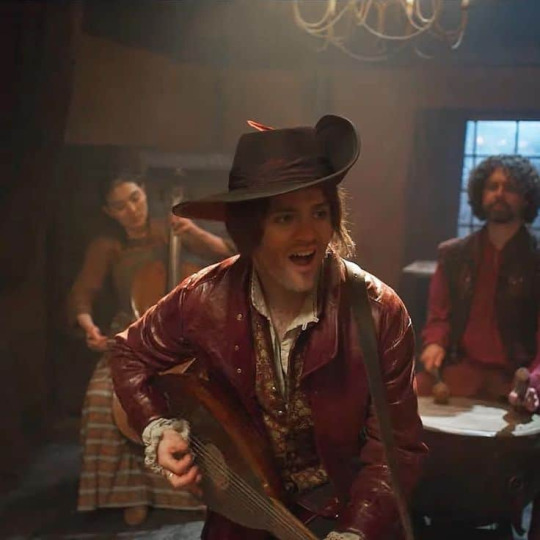
And though there has been some criticism over his look in season 2, I actually think he looks better with longer hair.

#Loki#The Witcher#Jaskier#Dandelion#The Sandman#Tales from the Crypt#Peter Vincent#Fright Night#Jim Henson's The Storyteller#Dungeons and Dragons#Dungeons & Dragons#Dungeons and Dragons: Honor Among Thieeves#Dungeons and Dragons: Honour Among Thieves#Dungeons & Dragons: Honor Among Thieves#Dungeons and Dragons: Honor Among Thieves#Dungeons and Dragons Honor Among Thieves#Dungeons & Dragons: Honour Among Thieves#dnd movie#Dungeons & Dragons Honor Among thieves#Dungeons & Dragons: Honour Among thieves#Xena#Xena: Warrior Princess#Gabrielle
38 notes
·
View notes
Note
do you have thor reading recs/guides/particular run or era to recommmend to get to know and appreciate the characters?
OOOH YES THANK YOU FOR ASKING
some thor fans and loki fans may disagree with what im gonna say here BUT. i think the run which best encapsulates why i love the character and the universe, as well as having essentially a very long guided tour through some of the most significant points of the thor sub-universe within the larger MU, is jason aaron's huge thor run from 2012 to 2019 (along with everything else happening in the thor universe at that time, covered by al ewing, kieron gillen, and marguerite bennett in a few also very good spinoffs).
this is the series where the God Butcher comes from, where Jane Foster becomes Thor, where loki is canon genderfluid in Agent of Asgard, where thor fights capitalism, and much more. it's not perfect, especially in terms of characterisation when some characters get thrown between their own miniseries and the main run, but it really encapsulates what I love about thor in his comics, and it's the run that, over the course of collecting the five huge paperback collections u can get it in, made me fall in love with this sub-section of the MU
proper reading order under the cut, plus brief explanations of crossover tie-ins and so on. it looks complicated but it's basically just cos marvel loves to re-start with a new #1 every so often to keep sales up, and because i think you should read the accompanying spinoffs. if you don't want to read the excess spinoffs (although agent of asgard is VERY good) just stick to things with 'thor' in the name.
Thor: God of Thunder (2012) #1-17
Loki: Agent of Asgard (2014) #1-5
Thor: God of Thunder (2012) #18-24
then the Original Sin event happens, the Watcher dies and a bunch of secrets are revealed...
Original Sin (2014) #5.1-5.5 (essentially a loki & thor miniseries tie-in, relevant to both series)
and THEN when Original Sin continues, Nick Fury (evil now, don't ask) whispers something into Thor's ear, and Thor drops his hammer on the moon and cannot pick it up! oh no.
Thor: God of Thunder (2012) #25
because the marvel universe never stops having big events, an event called AXIS happens immediately after, and results in a bunch of 'heroes' and 'villains' being 'inverted' - the 'villains' becomes 'heroes' and vice versa. both thor and loki are involved in this, covered in:
Loki: Agent of Asgard (2014) #6-11
and if you're wondering what happened to Angela after that Original Sin tie-in:
Angela: Asgard's Assassin #1-6
Thor (2014) #1-8 and Annual #1
THEN Secret Wars happens, basically 8 month timeskip and the multiverse is ending and another earth is about to crash into the main earth. don't worry about it.
Loki: Agent of Asgard (2014) #12-17
Secret Wars continues, the multiverse died and a new 'Battleworld' is created. basically it's a patchwork of all previous universes held together by Doctor Doom (don't worry about it). Marvel cancelled every single book and everything to turned into battleworld tie-ins:
Thors (2015) #1-4
1602 Witch Hunter Angela (2015) #1-4
... and then everything goes back to normal.
Mighty Thor (2015) #1-6
Angela: Queen of Hel (2015) #1-7
Mighty Thor (2015) #7-14
Unworthy Thor (2016) #1-5
Mighty Thor (2015) #15-22
Generations: Unworthhy Thor & Mighty Thor #1
Mighty Thor (2015) #23, #700-706 (they reverted to legacy numbering, don't worry, you didn't miss 677 issues of the series)
Mighty Thor: At the Gates of Valhalla #1
Thor (2018) #1-11
and then The War of the Realms begins, the big thor-centric crossover which ends the run. the issues of that main series and the concurrent thor series should be read in release order which looks like this:
War of the Realms #1
War of the Realms #2
Thor #12
War of the Realms #3
War of the Realms #4
Thor #13
War of the Realms #5
War of the Realms #6
Thor #14-16
and a concluding epilogue miniseries:
King Thor (2019) #1-4
#marvel#thor#lily dot tee ex tee#alternatively: the new 'immortal thor' series that's started is REALLY GOOD and al ewing really understands thor as a character#it's more of an unorthodox look at his universe (as you'd expect from the writer of Immortal Hulk)#but it's phenomenal so far (as you'd expect from the writer of Immortal Hulk)
6 notes
·
View notes
Note
why is it biphobic to have loki as pan? he’s pan in the myths?
It’s biphobic to write and say Loki is pan when multiple writers and those at marvel have confirmed Loki to be Bisexual. Even at one point, Loki’s actor had been told that Loki was canon bi in the comics while at a Dark World carpet premier (2014). He only said Loki was Pan years later while on a comic con (around 2018, after Lee’s mess) interview with lizzie Olsen (and you should know by now never to listen to an actor when it comes to what they know about the comic character). Loki has been bisexual and genderfluid for almost ten years and was officially confirmed in 2013/2014 by both of the writers of young avengers and agent of Asgard. And now recently confirmed once again by the writers of the Loki (2021) tv series.
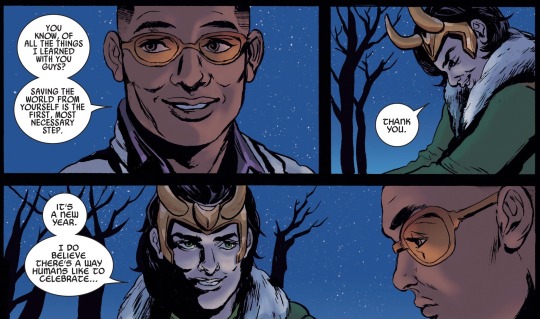
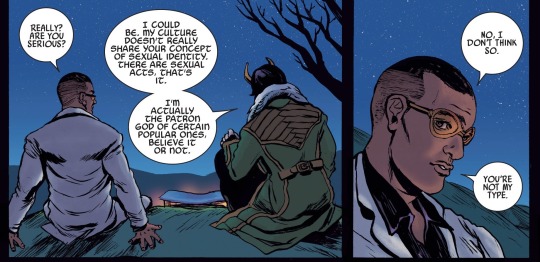
Young avengers (2013) #13

From this article
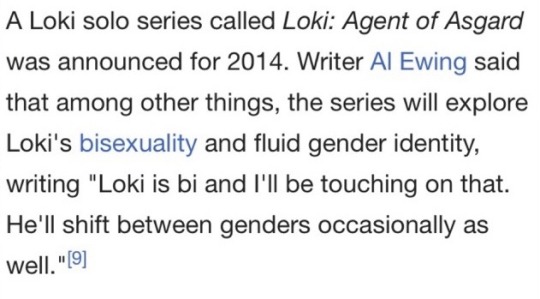
From the Loki wiki
However, the myths can be interpreted by everyone differently. I wouldn’t put a label on Loki personally because one; they use pansexual for him because in one myth he had sex with a horse and that, to me, just feels panphobic (however I would rather you listen to a pansexual person speak on this issue than I because I’m bisexual and their voice should be put before my own). And secondly; those labels did not exist back then. Those labels came from post colonialization so I just wouldn’t really use it because it was more of a love whoever you love back then, regardless of gender. If you think myth!Loki is Bi, then he’s bi. If you think myth!Loki is pan, then he’s pan.
Each person has their own interpretation of mythical Loki but that is neither here nor there when it comes to comic/mcu Loki. The two beings are different characters entirely and should be treated as such. In comic canon Loki is Bi and erasing that or changing his sexuality is in fact bisexual erasure which is biphobic. The only reason people believe Loki to be pan stems from a biphobic (and I learned a little bit ago that she is also transphobic), author Mackenzi Lee. She wrote a YA novel based on comic Loki and while not canon to marvel’s stories of Loki, she did state that this is in fact comic Loki so she did disregard his sexuality and furthered bi erasure.
I hope this explains everything for you and yeah, Loki is canonically bisexual for marvel. Have a good day!
#loki laufeyson#bi loki#myth loki#mythical Loki#bisexual loki#Loki#Loki comics#Loki agent of Asgard#agent of Asgard#I’m saying this as kindly as I can bc#I hate having this argument bc it’s just always the same thing repeated#I’ve explained everything best I can. if I overstepped any boundaries please correct me and I’ll fix it immediately
108 notes
·
View notes
Text
To celebrate Loki being confirmed as canonically queer in the Loki series, please enjoy this 12,000 word, fully referenced dissertation exploring Loki’s genderfluidity in Norse Mythology and Marvel comics....
Myth-gendering Loki: Changing attitudes to gender non-binary in the afterlives of the Prose Edda.
Abstract
This dissertation focuses on the character of Loki in the Prose Edda and in Marvel Comics as a way of exploring non-binary gender. The first chapter will use myths involving Loki as case studies through which a queer reading of the Prose Edda can be performed. Developing on the notion that the gender ambiguity in the Edda sets the foundation for Loki being a queer character, the second chapter will acknowledge how some of the most recent interpretations of Loki have fully embraced this aspect of his character and will therefore examine how this is presented through the two different mediums of comics and novels. The value of queer reading means that greater representation can be found not just in modern texts but can be sought out in the historical as well. Through the course of this dissertation, the importance of queer representation has been argued with regards to its place in history and to young adult audiences.
List of Illustrations
Figure Page
1. Stan Lee et al Journey into Mystery (New York: Marvel Comics, 1952), #85 35
2. Al Ewing et al Loki: Agent of Asgard (New York: Marvel Comics, 2020), #2 35
3. Al Ewing et al Loki: Agent of Asgard (New York: Marvel Comics, 2020), #14 35
4. Al Ewing et al Loki: Agent of Asgard (New York: Marvel Comics, 2020), #2 35
5. Al Ewing et al Loki: Agent of Asgard (New York: Marvel Comics, 2020), #5 36
6. Al Ewing et al Loki: Agent of Asgard (New York: Marvel Comics, 2020), #16 36
7. Walter Simonson et al, Thor (New York: Marvel Comics, 1966). #353 36
Contents
List of Illustrations
Introduction: ……………………………………………………………………………………………………………… 1
Chapter One: Loki in the Edda: ………………………………………………………………………………….. 4
Gender Ambiguity: ………………………………………………………………………………………… 5
Sexual Deviance: …………………………………………………………………………………………… 10
Race: ……………………………………………………………………………………………………………… 15
Chapter Two: Loki in Marvel: ……………………………………………………………………………………. 20
Genderfluidity: ………………………………………………………………………………………………. 21
Existing as Queer: ………………………………………………………………………………………….. 28
Identity: …………………………………………………………………………………………………………. 30
Conclusion: ………………………………………………………………………………………………………………… 37
Bibliography: ……………………………………………………………………………………………………………… 39
Introduction
‘The greatest power of myth: it never stops changing, yet its appeal is eternal’.[1]
Mythology is not something which is set. With every telling and retelling it changes over and over. Even before Snorri Sturluson wrote the Prose Edda in C.1220, the myths he would commit to paper had undergone countless changes innumerable times. Once they had found their way onto the page, the assumption that they would remain there, unchanged, is therefore unwarranted. As Christopher Abram states: ‘Myths of the Pagan North have grown, changed and developed to meet the needs of the new situations in which they find themselves’.[2] With regards to this concept of changeable mythology, this dissertation sets out to examine how the Prose Edda has been changed and developed to adapt to the requirements of modern societies. Using the character of Loki as a point of entry, this dissertation will examine how the Prose Edda has been interpreted to meet these requirements, centring around the concept of non-binary gender. To achieve this, both the original text and Marvel Comic’s interpretation of Loki will be examined through a critical gender and queer perspective.
Gender as something else which is not fixed is an idea first suggested by Judith Butler. Her 1990 book Gender Trouble theorises the concept of performative gender, suggesting that masculinity and femininity are not fixed and are instead performed identities which are acted out constantly. In short gender is not a matter of biology, but instead something governed by the arbitrary rules of a heteronormative ethos. These rules, therefore, can be broken leading to the rise of gender identities that exist outside the sphere of heteronormativity. Genderfluidity and non-binarism define themselves as resistive to the conformed ideas of a binary between masculine and feminine. These terms are not only useful for defining gender identities found in our modern societies but can also be used as tools to re-examine the Edda with, using a queer lens to scrutinize gender performance in this text.
The queer lends itself effectively to the Edda because of the numerous examples of gender inversions. The Poetic Edda especially features gender deviance, with Thor crossdressing in the Thrymskviða,[3] and the questioning of Odin’s masculinity in the Lokasenna.[4] However, for the purpose of this dissertation, only Loki’s role in the Prose Edda will be examined due to it being the most consistent in terms of gender ambiguity and elements of the queer. Although Loki changes between male and female in both this text and the Marvel texts, the pronouns of he/ him will be used to remain consistent with the primary texts. Queer scholarship of the Edda does have some recent precedents, with critics like Brit Solli examining the role of Odin as a queer god, but historically the queer elements of the Edda have been explained away.[5] The main reason cited for this is the difference between the perception of the queer today and of its perception during the composing of the Edda. Although it is true that placing modern terms onto historical texts and forcing certain characters into categories that did not exist at the time can be problematic, this does not mean that a queer reading does not have relevance. Instead, it opens a new way of understanding a culturally significant text.
The Edda has experienced multiple literary afterlives, from Wagner’s Ring Cycle to a significant influence on Tolkien’s work. Most people, however, will first encounter Norse mythology through the medium of Marvel, especially after the phenomenon of the Marvel Cinematic Universe. This is why two Marvel texts, Al Ewing’s 2014-15 comic series Loki: Agent of Asgard and Mackenzi Lee’s 2019 Young Adult novel Loki: Where Mischief Lies, have been selected as examples of how mythology has been adapted to meet the needs of their new situation, namely queer representation. Loki is canonically queer in these texts, both in his sexual orientation and gender identity. Increasing diversity has been a clear part of Marvel’s agenda over the last decade, though usually through the introductions of new characters, like Kamala Khan as Ms Marvel. Loki is one of the few already established characters to be reinvented as queer. Although Marvel’s Loki is an entirely separate character to the one found in the Edda, he retains the same archetypical characteristics ensuring he resonates with the original. Whether queerness is one of these innate to Loki and is therefore essential to his character will be examined.
Why Loki so effortlessly lends himself to queer interpretations, evidence of his genderfluidity as well as the intersection of the queer, gender and race will be explored in the first chapter. Marvel’s interpretation and embracement of Loki as a genderfluid and queer character will be the focus of the second, examining how genderfluidity is presented, the pressure to conform to heteronormative societies, and the overarching issue of identity. More widely, this dissertation will argue for the queering of characters from the Edda in modern adaptations.
Chapter One: Loki in the Edda
The Prose Edda is one of our main sources for Norse Mythology. However, as it was written in Iceland around C.1220, the Edda was composed several centuries after Norse paganism had been widely practiced with Christianity replacing it as Iceland’s main religion.[6] The author Snorri Sturluson himself was a Christian and, according to Robert Kellogg, ‘largely functions as a collector or reteller’.[7] I mention this not to question the authenticity of the Edda, but to demonstrate that mythology is always subjected to change. Jan de Vries argues that Norse Mythology has undergone three different stages; a period without Christian influence, suppression from Christian forces, and a final version corrupted by a Christian presence.[8] Those backlashing against diversifying mythological figures often cite ‘original’ texts like the Edda, suggesting diversifying is corrupting the ‘real’ version of this figure. If the oldest existing version of Loki was changed to fit a Christian narrative, why should he not be changed again in modern texts to fit a narrative of queer representation? Nevertheless, this chapter will use the Edda as a way of finding evidence that even this version of Loki has innate queerness.
In the Gylfaginning, where Snorri lists all the main gods, Loki is positioned in between the male Æsir and female Asyniur.[9] Anna Birgitta Rooth refers to this position as a ‘special appendix’[10] which separates Loki from the Æsir gods he is ‘reckoned among’.[11] He is listed after the minor Æsir, making him the last of all the male gods, as this denotes his position as an outsider in the gods society. It also places him in between the male and female categories, hinting at his gender ambiguity. Snorri makes sure that Loki’s sexual deviancy is presented to his audience by listing Loki’s monstrous offspring alongside him, ‘One was Fenriswolf, the second Iormungand (i.e. the Midgard serpent), the third is Hel’, in addition to his mixed racial heritage. [12] When stating Loki’s name, ‘He is Loki or Lopt, son of the giant Fabauti’, Snorri identifies him as the child of the enemies of the gods. [13]
In Loki’s first significant appearance in the Edda, it is possible to read gender ambiguity, queer sexual deviance, and racial anxiety. Some readings of the Edda will try to explain these elements of Loki away. [14] For example, Rooth argues against examples of Loki sexual ambiguity as ‘a motif used to produce comical effects and situations’.[15] This dissertation will instead embrace queerness in the Edda, using Loki as a focal point that intersects gender ambiguity, sexual deviance, and racial anxiety. These three elements of Loki will form the structure of this queer reading of the Edda.
Gender Ambiguity
Before analysing the gender binary found in the Edda, it is important to establish what this meant to medieval Scandinavian societies. For the time of the Edda’s creation and the subsequent oral tradition of Norse myths, Thomas Laqueur defines a ‘one sex model’ where ‘to be a man or a woman was to hold a social rank, a place in society, to assume a cultural role, not to be organically one or the other of two incommensurable sexes.’[16] With regards to this model, Carol J. Clover argues that male and female were not considered opposite in the way modern societies tend to view them. Instead there was ‘a social binary, a set of two categories, into which all persons were divided, the fault line runs not between males and females per se, but between able-bodied men (and the exceptional woman) on one hand and, on the other, a kind of rainbow coalition of everyone else’.[17] This meant that gender was not necessarily assigned to biological characteristics but social ones and, consequently, fluctuated with social status. This can be linked to modern gender theories regarding the connection, or lack of, between biological sex and gender identity. Butler’s theory is particularly notable, arguing that ‘there is no gender identity behind the expressions of gender; that identity is performatively constituted by the very “expressions” that are said to be its results’.[18] However, during the Norse period, Clover notes the peril that came with this one-sex system: ‘Not only losable by men, but achievable by women, masculinity was in a kind of double jeopardy for the Norse man’.[19]
The notion of losable and achievable masculinity is illustrated by a story found in the Skaldskaparmal section of the Edda. After the kidnapping of Idunn (which Loki both caused and remedied), the giantess Skadi ‘took helmet and mail-coat and all weapons of war and went to Asgard to avenge her father’ the giant Thassi, who had been killed by the Æsir gods. [20] As part of her compensation for this, Skadi demanded that the gods made her laugh, believing this would be impossible. The task fell to Loki who uses a rather unconventional method: ‘he tied a cord round the beard of a certain nanny-goat and the end round his testicles, and they drew each other back and forth and both squealed loudly. Then Loki let himself drop into Skadi’s lap, and she laughed’.[21] Each character in this tale represents a different aspect of fluidity within the Norse gender binary: Loki represents the loss of masculinity; Skadi represents the gaining of masculinity and the goat itself represents a kind of sexual ambivalence.
Loki’s loss of symbolic masculinity is demonstrated through physical loss in this mock castration. Stefanie von Schnurbein describes this as ‘an act that places his dubious sexuality and gender identity in a grotesque light’.[22] Loki is not only physically sacrificing his masculinity, but his symbolic masculinity simultaneously. This demonstrates ‘dubious sexuality’ because Loki is displaying his testicles in a show of masculinity only to have them symbolically removed by an animal. This willingness to sacrifice his physical gender characteristics supports Butler’s concept that gender is performative and therefore has no relation to biological sex because Loki takes on a performative role, playing a sexually impotent male. Consequently, he is placed into the gendered jeopardy that Clover suggests since he loses his maleness and, therefore, his social status. This reduction in status is a fitting punishment for Loki who betrays both the gods and the giants earlier in this myth so ends up being humiliated for their entertainment. Clover notes how in Medieval Scandinavian society ‘there was finally just one "gender," one standard by which persons were judged adequate or inadequate, and it was something like masculine’.[23] In this system, Loki is undoubtedly found inadequate, and fails to meet the standard of masculinity, placing him on the opposite side of the binary.
Evidence of this decreased masculinity can be found in the position Loki ends up in. He falls into Skadi’s lap, thus ends up sitting on top of her which, in addition to his exposed genitals, creates a sexually charged image.[24] However, Loki is in the female position while Skadi is in the male for this pseudo sex position.[25] Clover notes how, despite gender not being connected to biological sex, the Norse gender system has a ‘dependence on sexual imagery’, meaning that Loki being positioned sexually as female adds to his decreased masculine status. [26] This demonstrates not only how Loki has lost his masculine status, but how Skadi has gained her own masculinity.
This increase in masculinity therefore increases Skadi’s status. She wears a helmet and mail-coat to take on the celebrated masculine image of a warrior; a position that was accessible to women in medieval Scandinavian society as long as they gained the necessarily masculine traits and became, as Clover states, ‘exceptional’.[27] It is this embodiment of the ‘exceptional woman’ that allows Skadi to take revenge in the first place. Preben Meulengracht Sørensen argues that in Medieval Scandinavian society ‘a woman cannot herself take revenge; she must do so through the agency of a man’.[28] Skadi refutes this. Although she does not repay the death of her father in violence, she succeeds avenging her loss through the humiliation of Loki, whose betrayal led to her father’s demise. On the other hand, Sørensen may be right to say only men can take revenge. Skadi has gained enough masculinity to be perceived as socially male within the Norse gender binary. She takes on the image of a warrior and goes to Asgard to demand compensation to restore her family’s honour. The fact her biological sex is female makes little difference. Clover explains that Medieval Scandinavian society was ‘a world in which a physical woman could become a social man’, and this is what Skadi achieves. [29] In later myths, such as the Lokasenna, she is seen feasting with the gods demonstrating her heightened status considering she is not only female, but a giant as well. Moreover, Skadi lives independently without a male guardian. Although she may replace her father with Niord, the husband she gains as part of her compensation for her father’s death, this marriage fails and Skadi lives alone. According to Clover, Medieval Scandinavian society was ‘a universe in which maleness and femaleness were always negotiable, always up for grabs, always susceptible to ‘conditions’.[30] Snorri’s literature provided a safe space to explore these ideas and push the limits of this system. A system that accepted a certain fluidity between genders, but the condition was always one that supported a transition from female to social male but derided the reverse.
The final and most surprising character in this myth is the goat itself. Although seemingly playing only a minor role, the goat symbolises sexual ambiguity and the transition between genders. The nanny-goat is a female animal with male characteristics such as a beard thus combines masculine and feminine in one form, making it a symbol of gender non-conformity. Beards particularly in Norse literature are symbolic of male vitality.[31] There is a connection, quite literally, between Loki and the goat which implies Loki himself is sexual ambiguous. The goat is the one who removes Loki’s masculinity, and therefore, is the vessel through which Loki transitions from physically male to socially female. Margaret Clunies Ross highlights the ‘symbolic equation here between Loki, who plays at his own castration and has a reputation for sex changing, and the sexually ambivalent nanny-goat with the beard and horns’.[32] John Lindow also suggests the presence of the nanny-goat creates doubt over Loki’s perceived masculinity: ‘if the beard attached to one end of the rope is here a false symbol of masculinity, what are we to make of the genitals attached to the other end?’.[33] It is important to remember that Loki himself ties the goat around his testicles. He chooses this method to make Skadi laugh and does so willingly. This disproves Rooth’s notion that Loki’s gender ambivalence is depicted by ‘the epic course of events’[34] since the feminine display here is Loki’s choice and raises the question: why would Loki willingly sacrifice his own physical and symbolic masculinity? Perhaps he does not. It would only be a sacrifice of masculinity if Loki had already embodied the ideals of a Norse man. Loki famously takes on physical female forms throughout the Prose Edda, such as during Baldur’s death[35] and The Fortification of Asgard[36] myths, meaning his masculinity is already questionable. If Loki is prepared to become physically female, becoming socially female matters little by comparison. Loki, after all, is the trickster god; he will use whatever shape, form, or gender to his advantage.
Clover describes the Norse sexual system as a ‘permeable membrane’[37] and stresses an interest in the ‘fluidity implied by that system’.[38] This is a system in which a person can choose to move between feminine and masculine if they do not care about the social consequences for their actions. As discussed previously with reference to Loki’s position in Snorri’s list of gods, Loki is already socially at the bottom of the male Æsir and his status places him in between them and the female Asyniur. With a status already this low, Loki loses nothing when he reduces his masculinity and embraces his position as a social female. To navigate the Norse universe with such a diminished status, Loki uses everything to his advantage, including embracing his own femininity.
Sexual Deviancy
There are multiple terms in Old Norse relating to sexual deviancy with ergi, nið, ragr, and argr, as the most common. Although their meanings do differ slightly, essentially, they are all insults declaring someone as cowardly, weak, and unmanly due to an association with queer sexuality. Ergi especially encapsulates this idea of weakness being associated with sexual deviance, making it the most fitting term to use in this subsection. It fits within Laqueur’s one sex model aligning courage and strength with the masculine, and weakness with the non-masculine. Evidence of the seriousness of these insults can be found within Icelandic law. Grágás, the oldest Icelandic law text to survive, states that ‘one is entitled to kill on account of these words’. [39] Floke Ström also states that ‘the law prescribes its most severe penalty, outlawry, for anyone who imputes womanly behaviour to another in the form of nið’.[40] The severity of the punishment highlights just how negatively sexual deviancy was viewed. Those guilty could be anything from accused magic users, effeminate men or those taking the receptive position in homosexual intercourse, referred to problematically as ‘passive homosexuality’ by some Norse scholars. Loki is associated with all three of these elements, even exhibiting all at same time in the myth of the Fortification of Asgard.
This myth is found Gylfaginning chapter of the Edda. To prevent a disguised giant builder from completing the fortifications around Asgard and claiming the sun, moon and Freyia as his payment, Loki transformed into a mare to seduce the builder’s horse Svadilfæri, which stopped the completion of the wall. However, ‘Loki had such dealings with Svadilfæri that somewhat later he gave birth to a foal’ called Sleipnir who becomes Odin’s own horse. [41] In this myth Loki is clearly ergi; he uses magic to become a female, is sexually penetrated leading to pregnancy thus proving his unmanliness.
Magic, or seiðr to use the Norse term, is associated with the feminine to the extent that ‘males are forbidden to practice seiðr because of its power to damage their essential, defining qualities as males’, according to Ross, and male gods use ‘its power at the price of moral impairment and symbolic feminisation’. [42] It is this moral impairment that closely links Loki and his ergi nature, raising an interesting debate surrounding this association. Is ergi considered immoral because of its association with Loki, or is Loki considered immoral because of he is ergi? Despite also being a seiðr user, Odin escapes most of its negative association with being ergi. It is not mentioned in the Gylfaginning and Kathleen Self explains Odin ‘is made more masculine through the omission of his performance of seiðr, and the distinction between masculine and feminine is maintained’.[43] It is no coincidence that the Gylfaginning, the part of the Edda that contains the introductions of the gods, omits Odin’s magic use while containing myths that highlight Loki’s morally dubious nature. This is the chapter that sets the expectations and conventions for the rest of the Edda and Snorri makes certain that his audience takes away these specified associations. It is only in the Lokasenna that Odin’s dubious use of feminine magic is addressed by Loki himself. Accusations of sexual deviance of are exchanged between the two of them, yet only appears to have a negative effect on Odin.[44] Ström describes Loki as ‘a shameless ergi’.[45] It is this word ‘shameless’ that is the distinguishing difference between the two gods. Like the previous myth, Loki embraces his dubious gender to his advantage, and it is this acceptance that makes Loki so problematic in the Norse conceptual universe. As von Schnurbein notes “(Loki) represents the "effeminate" man and, for that reason, not necessarily because of his malevolence, is subject to derision and considered evil’.[46] He threatens the gods by undermining their one sex system. By embracing magic and resulting unmanliness, Loki challenges the concept that masculine is the pinnacle gender to which members of both genders should strive to achieve.
Further challenge to this system is seen in Loki through the connection his ergi nature has to femininity, specifically effeminate men. According to Ström, if the term was used to insult a woman, it was ‘virtually synonymous with nymphomania, which was a characteristic as much despised in women as unmanliness was in a man’, meaning its connotation of femininity were only applicable to men. [47] In the Fortification of Asgard myth, Loki performs the ultimate female act by both conceiving and giving birth to an eight-legged horse. A further old Scandinavian law that demonstrates just how transgressive this was: ‘the Norwegian laws already mentioned include insults likening a man to a female animal (berendi) among the words liable to the highest personal recompense. To liken a man to a male animal cost only half as much (halfréttisorð). Accusing a man of having given birth to a child… is added by the Gulathing Law to list of ‘full penalty words’ indicating the severest recompense to be paid’.[48] Both insults are applicable to Loki in this myth, demonstrating how morally corrupt he was in the eyes of Medieval Scandinavian society. The fact that these insults are gendered, with the female insult being the costliest, demonstrates how the one sex system impacted life within Medieval Scandinavian society. Everything comes back to the idea that masculine was not just the desirable gender, but the only gender which could gain honour and respect. Sørensen examines the moral repercussions of this connection: ‘the effect of nið was founded on the accepted complex of ideas about effeminacy and of effeminacy as identical with immoral, despicable nature’.[49] The reason these Norse terms for sexual deviance were so offensive is because of their association with femininity; whether it be seiðr’s connection with women, or the idea that a receptive male in homosexual intercourse was taking the female position. Ström agrees ‘that it is the feminine sexual role which makes allegations of ergi particularly injurious and in fact intolerable for the recipient’.[50] This is another aspect of ergi that Loki fulfils.
It is important to note that ergi and the other terms do not translate into modern ideas of homosexuality, something Brit Solli emphasises: ‘the term ergi must be understood contextually and not as a synonym for homosexuality, as we understand it today’.[51] The term is only applicable to those seen as taking the female position, whereas Clover notes ‘the role of the penetrator is regarded as not only masculine but boastworthy regardless of the sex of the object’.[52] Loki represents the concept of the penetrated male in this myth, considering the conception of Sleipnir, and this is an example of his immoral character. Although Loki’s negotiations and tricks save the Æsir, he is not the hero of the myth. That role goes to Thor who kills the giant with his hypermasculine, physical prowess, thus embodying the image of ultimate masculinity and its valued perception within the one sex system. Loki cannot be the hero because of his queer nature with its connotations of cowardice and corruption. Snorri explains that Loki ‘being afraid’ of the Æsir gods’ threats was the reason he changes shape and gender to seduce Svadilfæri which conveys the link between ergi and cowardice. [53] Sørensen explains how ‘in ancient Iceland consciousness, the idea of passive homosexuality was so closely linked with notions of immorality in general that the sexual sense could serve to express the moral sense’.[54] This means that, despite saving the Æsir, Loki still represents immorality. Snorri states Loki ‘is responsible for most evil’ in this myth, even though his only offense was to give poor advice. [55] His supposed evilness therefore comes from the queer gender inversion employed to fix his mistake.
Although not a hero, Loki is still powerful despite deflating his status by transgressing against the Norse gender system. In fact, it is this very transition that gives him power. Anthony Adams acknowledges that ‘Loki represents a type of imprecise, androgynous (or even hermaphroditic), yet still potent sexuality that is entirely at odds with the simpler, overt masculinity of the sagas’.[56] This conflict between Loki’s transgressive position as a queer character and the hyper masculine gives Loki power despite his low status. As much as they distrust Loki, the Æsir need him. The very fact they allow Loki to live amongst them demonstrates how important his transgressive abilities are, especially those associated with ergi such as magic. Soli reasons that ‘Seiðr must have been so important for the maintenance of society that the queerness of its practice had to be accepted as a cosmological necessity’.[57] Therefore, all the Æsir are guilty of engaging with queerness through their tolerance of Loki but only when he can be used to meet their needs.
When it comes to summarizing Loki’s sexual deviance, Ross best expresses how Loki and Odin ‘make good use of their ‘weakness’ (ergi) which allows them access to resources or patterns of behaviour normally regarded as female and hence unavailable to male beings’.[58] By embracing his ‘unmanly’ nature, Loki takes advantage of areas of power restricted from the higher status masculine gods and suppressed within female gods. Unlike Odin, whose ergi is ‘undoubtedly a burden’ (Ström), Loki does not care about the social (or any) consequences of his actions as long as he can use them to survive within the one sex system he simultaneously transgresses against. [59]
Race
Loki’s resistance to fitting within the gender binary is paralleled in his resistance to fit within the mythological race binary between the gods and the giants. His very existence bridges these two opposing races. According to Snorri, Loki is the ‘son of the giant Farbauti. Laufey or Nal is his mother’,[60] the latter Ross theorises was ‘presumably among the Æsir’.[61] This dual heritage unites the two enemy races within one being, meaning Loki is neither giant nor god but an unconventional combination of both.[62] Ross goes on to explain that this means Loki ‘is the embodiment of the most tabooed social relationship in Medieval Scandinavian society’.[63] Existing in between these races, Loki brings together the cultural aspects of both races despite their clear binary differences. By examining the threat Loki’s heritage presents amongst the gods and its connections to femininity, it is possible to see how Loki’s lack of conformity to the Norse racial binary demonstrates his resistance to the gender binary system too.
Loki is not only a product of a taboo relationship, but the participator in one too. From his relationship with the giantess Angrboda, Loki has three children who take the monstrous forms of Fenris, a giant wolf, Iormungand, a giant serpent, and Hel with her half dead body.[64] The gods ‘felt evil was all to be expected of them’[65] and imprison Loki’s children ‘because of their mother’s nature, but still worse because of their father’s’.[66] Despite possibly being half Æsir, it is Loki’s lineage the gods fear more than the full giant blood of Angrboda. This is because he embodies the union of two races whose conflict makes up a key aspect the Norse conceptual fabric. A typical trope of Norse mythology involves the morally superior Æsir gods defeating the monstrous giants, thus maintaining their system of ideals throughout the realms. Even when there is an exception to this, such as Thor being out-witted by Utgarda-Loki, the story still centres around the opposition of gods and giants, not their union as Loki represents. [67]
Loki does not fit within the usual racial structure of the society within Norse mythology. Ross describes Loki as an ‘anomalous being’[68] and notes how ‘the myth of Loki and his offspring indicates the kinds of disorders the gods oppose is not only ‘out there’ in the other world they associate with giants but exists within their own society’.[69] Loki is the product of two races that should be always in contrasting conflict, not uniting sexually, and even his presence amongst the Æsir presents a threat to their strict structures that maintain order. The very fact Loki exists undermines the whole system which sees gods and giants as opposite and opposing binaries.
One reason why the gods and giants live in such opposition is due to their opposing gender systems. While the gods live within a one sex model where hyper masculinity is the true gender and all others are inadequate, the giants’ system contrasts this. They fall within Clover’s ‘rainbow coalition’ making them ‘other’ to the Æsir. [70] Ross explains the connection between giants and femininity as a result of both concepts being treated as ‘other’ and ‘so the combination of the category ‘giant’ with the category ‘female’ represents an intensification of the nation of otherness and therefore an intensification of the association of danger with it’.[71] This adds to the threat of Loki existing within the Æsir gender system. Not only does he embody femininity through his non-binary gender and sexually deviant nature, his giant blood also adds to his innate gender inversion. Self also examines the connection between race and gender: ‘the binary of the gods and the giants echoes the male/female divide with the giantesses appearing more masculine at times and certain giants having a malleable gender’.[72] Skadi is example of this, but her gender is malleable in a way that is in tune with the Æsir one sex system meaning she is the only giant who is welcomed into their society.
Loki also uses his divine heritage as a way of embracing aspects of his femininity. Ross points out that Loki is ‘always referred to as Loki Laufeyjarson (which) indicates the precedence of his divine kinship through his mother’s family’.[73] While it does make sense that Loki would want to be associated with the parent with the higher status and assimilate with the gods by emphasising his racial connection to them, this still transgresses against the Norse patronymic system. By taking a matronymic surname in place of his father’s name, Loki is bestowing an honour usually reserved for men to his mother. This demonstrates his willingness to embrace femininity if it results in increasing his status amongst the gods, therefore we again see Loki using typically eschewed femininity to his advantage.
Although treated as an anomaly, Loki is not the only member counted among the Æsir to have giant ancestry. Both Tyr and Odin also are descended from giants; a fact the Gylfaginning conveniently forgets during their introductions. However, it is no coincidence that both these gods are hypermasculine war gods which places them firmly at the top of the one sex model. Therefore, their desirable masculine traits compensate for their undesirable, unorthodox lineage. Loki’s lack of conformity within the gender system is what makes his mix heritage a problem for the rest of the gods. By not fitting within their system of gender, his race is just another aspect that makes him a threat. Nevertheless, as with his queer nature, the gods will often use Loki’s liminal position between the two races. Rooth notes that Loki’s ‘role is frequently that of mediator’[74] between the gods and the giants but John McKinnell also notes his ‘special role is as a traitor’.[75] The gods depend on Loki’s nonconformity to navigate situations which their strict morality prevents them engaging with, such as magic and interrace relations, and still hold the very aspects of Loki that they need against him. McKinnell reasons that Loki shares these undesirable yet essential traits with other gods but ‘unlike the others makes no attempt to hide them’.[76] This is what makes Loki a true threat to the gods. It is not so much his engagement with taboo practices, but his openness. His refusal to hide his transgressive nature highlights the hypocrisy within the gods and flaws within their binary systems they try to hide.
Conclusion
Loki in the Prose Edda is clearly a transgressive character who resists categorization within the concept on the one sex model. His race, sexual deviance, and complete disregard to gender binaries combine to create a male entity who openly and happily engages with femininity without shame or fear of the social ramifications. However, while modern terms such as gender non-binary, or genderfluid may seem applicable to him, it is important to remember that the gods of the Edda are not characters but mythological concepts, with Thor embodying the concept of strength, Odin wisdom and so on. Loki’s mythology offers a safe arena in which cultural taboos can be broken and their consequences examined. Therefore, he does not have a gender identity in the same sense a modern fictional character has, so cannot identify as gender non-binary or fluid. As A. S. Byatt states mythological figures ‘do not have psychology.... They have attributes’.[77] Loki is instead a vessel through which the concept of gender binary within a one gender system can be explored and ultimately critiqued and punished. As the antagonist of the Edda, he brings forth the destruction of the gods. Loki destroys not only the Æsir hierarchy but the entire Norse universe during Ragnarök.[78] The Norse universe is one that relied on these binaries to exist and collapses once they are destroyed. The concept of Loki cannot survive in the one sex model, and the model cannot last with Loki in it. However, if Loki is removed from this gender system and placed within a modern one, his role and his outcome is entirely different.
Chapter Two: Loki in Marvel
Prior to the 2014 release of Loki: Agent of Asgard, a new comic series which centred around the reimagined, teenage version of the trickster god, the writer Al Ewing confirmed that Loki would indeed be a queer character who would switch between genders.[79] This came as no surprise to many in Loki’s fanbase since evidence of Loki’s queerness can be found throughout his history in Marvel comics. Examples of this include; flirting with a male teammate in Young Avengers Vol 2,[80] the ambiguous sexuality that comes with possessing a female body in Dark Reign[81], to even his first appearance in the modern era of comics in Journey into Mystery #85[82] where he is given a feminised, hourglass figure in contrast to the broad masculine figure of his counterpart Thor. (Fig. 1) However, in his own comic book, Loki’s character could now embrace his queerness and his gender fluidity in his own body much more openly than before.
The recent 2019 young adult novel Loki: Where Mischief Lies written by Mackenzi Lee will be examined alongside this comic. Like the comic, this novel also features an openly queer and gender non-conforming Loki. Both versions of this character face similar problems as they struggle to find their place within the wider narratives of the Marvel universe, especially concerning where they fit within the gender structures and heteronormative worlds and their roles as presumed antagonists.
Unlike the Loki found in the Edda, both Loki in Agent of Asgard and Loki in Where Mischief Lies are fully fleshed out characters with their own identities and motives, especially now they are the protagonists of their stories rather than just antagonists used to highlight the heroism of their adversaries. As a result of their enhanced characterisation, they become representative of genderfluid and non-binary people. Marvel’s acceptance of queer characters is something to be commended. As Mathew McAllister notes ‘comics mirror a pluralistic society’, therefore Marvel presents a fictional society that reflects our own. [83] Underneath stories of gods and heroes, the two texts explore queer gender identities and what it means to exist as ‘other’. This chapter will explore this by analysing how gender non-binarism, transgression and identity feature within Ewing’s and Lee’s stories.
Genderfluidity
By reimagining the mythological concept of Loki in a modern society, he is removed from the one sex model Laqueur suggests for Norse literature and placed in a new gender system. This new system, according to a contemporary critical lens using Butler’s theory of gender, is one based on the notion of performative gender and therefore allows for fluidity between them. However, the concept of gender being directly related to biological sex along with ideas of masculine and feminine being separate and opposite are still prevalent in most societies. Agent of Asgard is set within a society reflective of our own. The comic takes place across Earth and Asgard within their similar performative gender systems.
Where Mischief Lies is slightly more complicated, taking place across two very different societies: the ‘idyllic paradise’ of Asgard and nineteenth-century London. [84] Gender binaries are strictly upheld in the latter, following a system in which women are perceived as inferior to men to such an extent that even wearing trousers is seen as being transgressive, and where homosexuality is criminalised. [85] Asgard contrastingly does not have ‘such a limited view of sex’, instead it is seemingly a society in which all genders are treated equally. [86] Yet, there still is a binary system in place that echoes the one sex model in the Edda. Rather than between male and female, it is between sorcerers and warriors with the latter viewed as the desirable trait and the other as inferior. Loki is encouraged to hide is magical ability and ‘dedicated himself to becoming a warrior’[87] because ‘no one wanted a sorcerer for a king’.[88] There is still a gendered aspect to this system, however. Similarly to the Edda, magic is closely associated with women, with the only magic users in the novel being female (Frigga, Karnilla, Amora) or Loki who is feminised. Whether magic is viewed as inferior because of this feminine association is unclear. Reflective of the one sex model found in the Edda, background female characters who pursue hypermasculine warrior lifestyles, Sif and the Valkyries, are praised while magicians are viewed with fear and suspicion. To observe Lee’s Loki in this system, and Ewing’s Loki in the Agent of Asgard system, this section will examine how the characters exists as both genders, how this is physically presented and how this disrupts each of their gender systems.
Although Loki changes genders several times throughout the comic series, the term non-binary or genderfluid is never used. Nancy Hirschmann identifies the issue of ‘what queer… individuals are called, by themselves and by others,’ as a ‘political, ontological, and epistemological issue’, however, this does not negate from the validity of an identity just because it is not labelled nor means it is not applicable. [89] The first example of Loki changing gender is in issue #2 where Loki takes the pseudonym ‘Trixie’ to infiltrate a heist. Although it could be argued that Loki only becomes female because it is a necessary disguise, as Rooth argues in the Edda, Loki explains that his illusion magic would not have worked in that situation. [90] ‘I am always myself,’ Loki states explaining that being female is no different from being male. [91] This is best demonstrated by a single borderless panel depicting Loki shifting between female and male. (Fig. 2) The lack of borders symbolises the lack of boundaries between Loki’s genders and the single panel means both genders are contained in a singular space as both genders exist within Loki. Panelling in issue #14 again demonstrates how Loki regards shifting between genders. (Fig. 3) The three panels picture male Loki putting on a shirt as he changes to female as if changing gender is no different from changing a shirt. According to Sandra Bem, an individual can contain both female and male traits, which means Loki exists as both female and male simultaneously; changing genders therefore is not an artificial act made capable through his magic abilities and is not done just because it is convenient for the situation. [92]
The most obvious evidence of Loki’s genderfluidity in Where Mischief Lies takes place in Victorian London, due to the scrutiny Loki faces when removed from the supposedly gender equal Asgardian society. Theo, trying to find out Loki’s sexual orientation, asks his preferred gender which Loki misinterprets and answers ‘I feel equally comfortable as either’.[93] When Theo argues that this is again simply because of Loki’s magical abilities allowing him to change appearance, Loki states ‘I don’t change my gender. I exist as both’.[94] The confusion between gender and sexuality highlights, according to Jonathan Alexander, how ‘sexuality intersects with and complicates are understanding of gender’ and further demonstrates the difference between the two gender systems of Asgard and Earth. [95] Loki’s misunderstanding conveys how gender and sexuality intersect so frequently on Asgard that he cannot separate them, while Theo is accepting of homosexuality yet struggles to understand genderfluidity. This is perhaps because Loki has to appear more masculine during his time in London, ‘he missed his heeled boots’, although, he still defends his feminine identity. [96] Whenever feminine terms are applied to him, Loki accepts them: ‘“It’s the feminine version of enchanter.” “Does that matter?”’.[97] The setting of Victorian era with its stricter gender binaries is effective for demonstrating the ‘the arbitrariness of the Western gender system’ through Loki’s critiques of it. [98] By framing these critiques as being ‘small-minded’ and associating them with conservative Victorians, Lee helps to validate queerness and genderfluidity, reflecting the diversity of her young adult audience. [99]
The visual medium of the comic means appearance becomes key for demonstrating Loki’s genderfluidity in Agent of Asgard and consequently meaning his genderfluidity is always present through the art of the comic. Like in his very first issue in Journey into Mystery, Loki’s male appearance is feminised. Black nail varnish, a fur lined coat and V-necked tunic all hint at his feminine nature while scaled armour and greaves are typically more masculine. (Fig. 4) The fact that both male and female aspects exist in one costume demonstrates how Loki is consistently both genders, especially because the costume does not change when Loki’ changes from male to female, or even a fox. (Fig. 5) Terrence R. Wandtke notes how a superhero’s costume is ‘a marker of self’, thus Loki’s androgynous costume represents his genderfluid self. [100] This also reflects Loki’s queerness in terms of his sexual attraction to both genders which is not particularly explored in depth in the comic. Aaron Blashill and Kimberly Powlishta refer to ‘cross-gendered characteristics’ in homosexual people which Loki’s costume captures, demonstrating not only is genderfluidity but his homosexual orientation as well. [101] It is also notable that Loki’s physical female appearance is very similar to his male. In the example of ‘Trixie’ in #2, the only difference between the male and female Loki is make-up and hair length. This accurately reflects how potential genderfluid readers use cosmetics to reflect their own transitions between genders thus proving how Loki becomes a representative for genderfluidity in literature.
Where Mischief Lies also relies on appearance to demonstrate Loki’s lack of gender boundaries. This is because, unlike Agent of Asgard Lee’s Loki never becomes completely female meaning clothing is often used to symbolise his innate femininity. Loki’s femininity is introduced when the novel opens with Loki worrying about his appearance. These concerns focus on aspects typically associated with feminine appearance, such as his love of ‘a bit of sparkle’[102] and his boots which ‘made him feel like doing a strut down the middle of the hall …(and had) heels as long and thin as the knives he kept up his sleeves’.[103] This evokes a feminine image of Loki with ‘strut’ in particular conjuring the queer image of a drag queen. The simile of knives as heels is particularly demonstrative of Loki’s gender fluidity, combining the feminine heel and weapons with their connection to masculinity within the hypermasculine Asgardian gender system. The use of clothes further validates the performative aspect of gender. Although Loki is biologically male, his choice of clothes demonstrates the feminine image he wishes to portray to the world. Lisa Walker expresses how the whole concept of performative gender relies on an individual performing the gender they think they are; Loki’s performance suggests he views himself as both male and female. [104]
A further way to examine Loki’s queer nature is to explore how it exists in contrast to the gender system in which it is found. Although the performative system in Agent of Asgard is in theory accepting of genderfluidity, there are still queerphobic elements that demonstrate that strict binary views of gender still exist. Loki is referred to as a ‘precious little girl-child’[105] and a ‘preening half-a-man’.[106] These both use Loki’s feminine gender as an insult, suggesting either the idea of femininity being a weakness, or that queerness is ‘viewed negatively due to a presumption … (of) cross-gendered characteristics’.[107] However, these are the only two queerphobic instances in a comic that is overall thoroughly embracing of Loki’s genderfluid identity. While some commentators on comics, such as Norma Pecora[108] and Carol Stabile[109], criticise the innate sexism in the comics of the 1990s, Marvel has made a substantial effort to improve female and queer representation in recent years, including recently featuring a pride parade consisting entirely of their LGBTQ+ characters, including Loki.[110] McAllister notes the power the comic book has ‘to both legitimate dominant social values and provide an avenue for cultural criticism’, therefore highlighting the importance of representation in comics and providing an accepting society to legitimise their presence both on and off the page. [111]A comic being void of any criticism of queer people would not accurately represent the prejudices LGBTQ+ people face, justifying the use of limited queerphobic remarks. Therefore, even in a fictional society that recognises the performativity of gender and provides a system Loki should exist easily within, the lingering prejudices of gender binaries means Loki is still seen as transgressive and, like the Edda, his queerness is used to insult him.
Despite Where Mischief Lies featuring two distinct binary systems, one sentiment combines how Loki transgresses both: ‘Be the witch’.[112] This sentence, which is not only repeated throughout the novel, but concludes it, brings together the idea of transgressing the gender binary of Victorian London as well as the sorcerer/warrior binary of Asgard. By being transgressive, Loki is a threat to both systems and the social hierarchies they uphold. In term of gender binaries, Hirschmann suggests that ‘those boundaries may be established by cultural practices as a way to protect social hierarchies’.[113] Victorian London has this system to defend the patriarchy from threats of female power. This can be seen from the character of Mrs Sharp whose masculine trousers brings her into conflict with the male authority, ‘“Why do you try so hard to look like a man, Mrs Sharp?”’,[114] and the use of ‘witch’[115] to insult Loki due to its association with powerful women. Loki’s presence as someone who openly embraces multiple genders threatens the rigid binary that protects the patriarchal system, resulting in his femininity being ridiculed due to the anxiety created from its threat to male power.
Within terms of the hierarchy system of Lee’s Asgard, in which magic is seen as inferior to warrior prowess, Loki transgresses through his magical ability rather than his genderfluidity. While Thor’s expression of physical power is praised, Loki’s magical power is punished or regarded with fear: ‘His father was afraid of him. Afraid of his power’.[116] Magic users who remain subservient, ‘Karnilla… Odin’s royal sorceress, stood like a soldier’[117] and Frigga, Odin’s wife ‘who supported him’,[118] are accepted in Asgardian society, while those who transgress, like Amora who is ‘too powerful to control’, are banished. [119] There is an obvious gendered narrative reflecting a woman’s place in society; her power must be subservient to the masculine ruler or she will be rejected. The concept of the witch, being a feminine magic wielder who exists outside of society, accurately reflects how Loki does not fit within either binary of the two systems found in Lee’s novel. For much of the novel, Loki struggles to be the subservient sorcerer Asgardian society desires him to be, but ultimately decides to embrace his transgressive nature and ‘be the witch’.[120]
Existing as Queer
In both texts, Loki exists as an outsider to the societies he seeks acceptance within. Although his queer identity and orientation are never directly cited as the reasons for this ostracization, they are emblematic of why he is never accepted. In Agent of Asgard, Loki’s genderfluidity translates into to a wider desire to resist being categorized as either a villain or hero, while shame over his magical abilities in Where Mischief Lies reflects a struggle to accept homosexual attraction. Loki’s othering as a queer character will be explored by examining how it is reflected through other aspects of his characterisation.
Categorization is expressed in Agent of Asgard through the repeated metaphor of boxes and cages. They symbolise a conformity with conflicts with Loki’s fluid and transgressive nature. Loki connects this idea of identity and boxes, ‘I am my own and will not sit long in any box built for me’, demonstrating how being his own means being innately transgressive. [121] Throughout the narrative Loki is trying to prove he is no longer the archetypal villain he had been for most of Marvel’s history. He will no longer fit neatly into that category nor the one of hero, instead existing between the two as an antihero. Like with gender, Loki does not fit in either binary meaning the threat of literal imprisonment is used to symbolise conformity as either a villain or as a single gender. At the climax of the novel when Asgard goes to war with Hel, Loki does not choose either of the binaries presented to him, stating ‘I don’t do sides’ in a panel that heavily shades half his face. [122] (Fig. 6) The combination of both dark and light colouring creates the impression that Loki is neither entirely good nor evil, instead he is both and neither; he has found a way to exist outside the binary of good and evil, reflective of his ability to exist outside a gender binary. Binary gender as being restive and box-like is something explored by Jennifer Nye: ‘the range of human possibilities extends far beyond that recognized by the gender box.’[123] Loki’s resistance to imprisonments represents a desire to break free of restrictive gender categories.
The concept of the gender box goes beyond just gender identity to include sexual orientation. Nye definition of the masculine gender box relies on the assumption that ‘if your sex is male, your gender is masculine, and you are sexually attracted to women’.[124] Of course this excludes anyone who is not a cisgender heterosexual, but it does demonstrate the traditional expectations of gender and sexual orientation, therefore making anyone who exists outside the gender box automatically an outsider. In Where Mischief Lies Loki and Theo’s homosexual feelings for each other mark them as outsiders in Victorian London where Theo has been previously imprisoned for being ‘a boy who likes boys’.[125] This is something Loki instantly relates to as ‘he knew what it was to be cast out and unwanted and taunted for the fabric you were stitched from.[126] While Asgard, according to Loki, is accepting of homosexuality, it is possible to map the clichés of closeted homosexuality onto Loki’s struggle to hide his magical abilities: ‘wriggling with a shame he didn’t understand, before his mother finally came and explained that it would be best if he did not use the magic’.[127] Unintentionally paralleling the Edda, magic becomes an othering force like seiðr in Norse literature. Like Theo, there is also a threat of punishment for this othering, which Amora experiences in her banishment. This connection between Theo and Loki being forced to hide who they really are leads to the shared sentiment: ‘I wish I could make your world want you’.[128] Existing as queer means embracing what makes you other. Something both Theo and Loki accept by the end of the novel with Theo kissing Loki[129] and Loki using his magic to save Asgard.[130]
No matter how accepting the society of Asgard is in Agent of Asgard or Where Mischief Lie’s, there is always the tendency to cast anyone who transgresses traditional views of gender and sexuality as a villain. Mark LaPointe and Meredith Li-Vollmer argue that ‘gender transgression may also cast doubt on a person’s competence, social acceptability, and morality’ in cultures that still hold on to ideas of ‘naturalized constructions of gender’. [131] Consequently, if Loki is to stay true to his own identity, he must exist outside of society, often causing conflict with it that presents him as antagonistic.
Identity
Loki’s exploration of his identity is a key theme not just in these two texts, but in the wider Marvel universe as well, with rumours an upcoming television series will also delve into this.[132] A fundamental aspect of Loki’s identity is of course his gender but this is just one aspect of many that result in Loki finding conflict between his own identity and the societies he longs to belong to. The way Loki is othered from society, how he exists as an othered being and his acceptance of his othered position will be examined in this section.
In Agent of Asgard Loki becomes increasingly othered throughout the comic. His position in this society has always been precarious; like in the Edda, Loki is racially other to the Asgardians[133] which is used to test his loyalties: ‘your race and mine are old allies’.[134] Although this is unsuccessful ‘We gave you a family’, ‘Yes, but I already have one of those’, Loki’s heritage is other enough for this to pose a threat, at least in the eyes of those within Asgardian society. [135] Loki begins the comic desperately trying to earn a place in this society by atoning for his crimes of the past, trading ‘new legends for old’,[136] but by issue #10 Loki’s secret of killing his child self, ‘the crime that will not be forgiven’,[137] is revealed leading to ostracization from Asgardian society. Loki consequently loses a key element of his identity: ‘I’m no longer an Asgardian’.[138] This concept of losable racial identity is not unlike the concept of losable masculinity in the Edda because Loki must meet the heroic requirements of Asgard or be cast out. Adam Green also argues that ‘identity as an ongoing social process marked by multiplicity, instability, and flux’ therefore can be lost or gained. [139] Loki’s exile ultimately frees him from the constraints of a society he was constantly in conflict with. Exile came because of Loki’s inability to live up to the expectation of Asgardian identity, with ideals of heroism that did not coincide with the trickster elements of Loki’s identity. While genderfluidity does not directly violate the concept of Asgardian identity, it is an expression of Loki’s malleable character that contrasts with the traditional image of the heroes of Asgard. Now he is separated from this society, Loki is finally free to explore his identity without restraints.
In Where Mischief Lies, Loki’s othering comes from his inability to find his place in a society that only values qualities such as physical strength and a warrior prowess. Like Ewing’s Loki, Lee’s is also desperate to find acceptance in society, ‘working to be a better soldier, a better sorcerer, a better prince’, with little success. Loki is aware of his otherness. [140] He is worried that magic will ‘make (him) unnatural’, and Amora’s banishment demonstrates how dangerous otherness is in Asgardian society. [141] Alexander argues that ‘our identities are shaped and communicated through a variety of interesting social processes’, therefore this othering would have significantly impacted Loki’s identity, particularly his gender. [142] Asgard is supposedly accepting of Loki’s genderfluidity, yet he is the only genderfluid character found in Asgard and his femininity associates him with the otherness of magic as the only male user. The concept of otherness in this society consequently forces conformity on Loki in his desperation to be accepted. Paradoxically, it is when Loki enters the more oppressive society of Victorian London that he realises his identity cannot be suppressed; to be true to himself, he must exist as other in Asgardian society.
Loki’s acceptance of his place as an outsider to Asgardian society is central to the development of his identity as a transgressive character. By being ostracised from his society, Loki no longer needs to fulfil any expectations apart from his own. This allegiance to nobody but himself if something that has been part of Loki throughout his history in Marvel comics. Ewing turns the idea of Loki’s selfishness into an idea of self-preservation of an identity othered by Asgardian society. In Agent of Asgard’s introduction Ewing cites the iconic panel from Thor #353, which Odin’s battle cry is ‘For Asgard!’, Thor’s is ‘For Midgard!’, while Loki’s is ‘For Myself!’. [143] (Fig. 7) While humorous, Ewing argues that ‘when your self is a thing you have to fight the very cosmos to decide… it’s almost kind of… heroic?’, demonstrating how Loki’s perceived selfishness is evidence of him fighting to preserve his own identity. [144] To be true his identity, Loki must exist outside the society he had been trying to appease: ‘I probably shouldn’t care what they think, then, should I?’.[145] Agent of Asgard is ‘a comic about being For Yourself’, about existing without apologising. [146] Loki’s genderfluidity is just one aspect of his identity that causes him to transgress against the society he tries to exist within. Rather than sacrifice his identity to be accepted by others, Loki choses to exist as an outsider.
Loki in Where Mischief Lies also accepts his place as being an outsider. He tries to find his identity through his position in society, by trying to prove that he is a worthy contender for the throne. However, throughout the novel Loki is forced to question his own sense of identity due to the way others perceive him: ‘He did not know who he was. Everyone knew but him’.[147] It is only at the very end of the novel once Loki finds out he will never be king that he accepts that he will always exist as other to his society, choosing to ‘serve no man but himself, no heart but his own’.[148] Forming an identity othered from society, Loki gives in to fulfilling the expectations of others, becoming ‘the self-serving God of Chaos’, but is also free to be true to himself. [149] This impacts Loki’s gender identity because he no longer needs to worry about what others think of him, leaving him free to explore his gender to its full extent.
The final, and most important, aspect of identity both texts explore is self-acceptance. After revealing that the antagonist of the narrative was really himself, Loki embraces him and tells him ‘it’s all right’, meaning Loki finally accepts himself and no longer strives to conform to become something he is not. [150] Lee’s Loki also accepts himself. While on Earth he meets other people othered by their societies, such as Mrs Sharp and Theo, and it is through their friendship that Loki learns to accept his otherness. Theo and Loki are both othered in their own societies, so instead find acceptance in each other, sharing a ‘soft kiss’.[151] Through this action, Theo accepts his sexual orientation and Loki accepts that he can receive affection without having to meet the impossible standards society expects of him. Self-acceptance is key to embracing one’s own identity, especially transgressive gender identities such as genderfluidity. McAllister highlights the importance of comic books and ‘the degree of cultural argument they permit or encourage’ meaning that Loki becomes a figure representative of genderfluid identities and validates their presence not just in literature, but in the world of the reader as well. [152] Therefore, it is critical that Loki in both texts learns to accept himself and his entire self. Not just as a genderfluid individual, but all aspects of his identity that makes him a fully fleshed character and not just a symbol of deviance as Loki in the Edda is.
Conclusion
The two texts explore Loki, not as simply a figure representative of transgressive gender, but as a character with a genderfluid identity that brings both internal and external conflict. Although Loki’s genderfluidity is an essential part of his identity, these texts prove that he is more than just his gender and that gender is more than just one aspect of his identity; it is a foundation in his otherness and symbolic of the malleability of his personality. The comic book industry was once notoriously slow to adapt to changes in the treatment of gender, with stories revolving around a hypermasculine hero protecting the delicate female, is now significantly more embracing of social progress. Loki is just one of a growing number of characters from LGBTQ+ backgrounds, yet he is one of the oldest to exist in Marvel comics. This is testament to the gender ambiguous legacy that the original mythological Loki left behind. The mythological Loki’s transgressive approach to gender reverberated across centuries, until it reached this modern medium where it could be expressed fully.
(Fig.1) Stan Lee et al, Journey into Mystery (New York: Marvel Comics, 1952). #85
(Fig.3) Loki: Agent of Asgard #14
(Fig.2) Al Ewing et al, Loki: Agent of Asgard (New York: Marvel Comics, 2020), #2
(Fig.4) Loki: Agent of Asgard #2 Jamie McKelvie Cover Variant
(Fig.5) Loki: Agent of Asgard #5
(Fig.6) Loki: Agent of Asgard #16
(Fig.7) Walter Simonson, Thor (New York: Marvel Comics, 1966). #353
Conclusion
‘Loki makes the world more interesting but less safe.’[153]
When Neil Gaiman wrote this in Norse Mythology, he was referring to the threat Loki poses to the gods of Asgard as the bringer of their downfall. However, I think that there is another way to interpret this. A world made ‘less safe’ does not necessarily mean a world of danger, but a world less conservative, less static, where diversity makes the world more interesting. To help this world come into being, it first must be accepted. This means not only in wider society but in popular culture too, by finding its way onto our screens and pages.
While this dissertation has praised Marvel’s efforts to increase diversity in its comic books, the Marvel Cinematic Universe is far behind its comic counterpart, especially in queer representation. At the forefront of this fight for LGBTQ+ depiction is the Thor franchise, with Tessa Thompson’s Valkyrie being the first, although unconfirmed, LGBTQ+ character originating in Thor Ragnarok.[154] Thor: Love and Thunder is also rumoured to introduce a transgender character and, while Loki’s place in this film is yet to be confirmed, there are again rumours he may be genderfluid in his upcoming TV series. There has always been controversy surrounding Marvel’s queer diversity, such as Brazil recently banning a Young Avengers comic due to a same-sex kiss being featured in it, which is the reason why Marvel’s mainstream movies have been so slow to increase representation in comparison to its comics. [155] However, the fact that it raises such controversy only heightens the need for greater representation.
Rick Roidan, during his acceptance speech at the 2016 Stonewall Awards, expressed the how important it is for ‘LGBTQ kids see themselves reflected and valued in the larger world of mass media’.[156] He too identified the connection between genderfluidity and Loki with his genderfluid character Alex Fierro being the child of Loki in Magnus Chase and the Gods of Asgard. Another example of mythology being repurposed for a modern audience, it furthers Abram’s argument that mythology will change to meet what is required of it. It also conveys the importance of representation that goes deeper than appearing in mass media, with these LGBTQ+ kids being connected to something even more engrained in culture.
The target audience of the modern texts explored in this dissertation are mainly young adults, many of whom will be beginning to explore their sexual identities and orientations. By queer reading mythology then using this as a basis for representation, queer identity is established as something validated by its presence in the past and position in popular culture.
Bibliography
Abram, Christopher, Myths of the Pagan North: the Gods of the Norsemen (London: Continuum, 2011)
Adams, Anthony, ''He Took a Stone Away’: Castration and Cruelty in the Old Norse Sturlunga Saga', in Castration and Culture in the Middle Ages, ed. by Larissa Tracy (Suffolk: Boydell & Brewer, 2013).
Adams, Tim, Thor: Ragnarok's Valkyrie Is Bisexual, Tessa Thompson Confirms (2017) <https://www.cbr.com/thor-ragnarok-valkyrie-bisexual/> [accessed 5 May 2020]
Alexander, Jonathan, 'Transgender Rhetorics: (Re)Composing Narratives of the Gendered Body.', College Composition and Communication, 57.1, (2005), 45-82 (p. 50), in ProQuest <https://search-proquest-com.ezproxye.bham.ac.uk/docview/220712396/fulltextPDF/BDE4C525A8C64762PQ/1?accountid=8630> [accessed 11 March 2020]
Bem, Sandra, 'The Measurement of Psychological Androgyny ', Journal of Consulting and Clinical Psychology, 42.2, (1974), 155-162, <http://citeseerx.ist.psu.edu/viewdoc/download?doi=10.1.1.472.525&rep=rep1&type=pdf> [accessed 11 March 2020].
Bendis, Brian Michael et al, Dark Reign (New York: Marvel Comics, 2008)
Blashill, Aaron, Powlishta, Kimberly, '“Gay Stereotypes: The Use of Sexual Orientation as a Cue for Gender-Related Attributes.” ', Sex Role, 61.1, (2009), 783-793
Butler, Judith, Gender Trouble, 4 edn (Suffolk: Routledge, 2007)
“ ” Bodies That Matter: On the discursive limits of "sex", 2nd edn (New York: Routledge, 2011)
Ciacoya, Bea, Brazilian Mayor Orders Armed Police Seize LGBTQIA+ Books, Leads to Protest (2019) <https://www.cbr.com/brazilian-mayor-orders-armed-police-seize-protest/> [accessed 5 May 2020].
Clover, Carol J., 'Regardless of Sex: Men, Women, and Power in Early Northern Europe', Representations, 1.44, (1993), 1-28
Ewing, Al et al, Loki: Agent of Asgard The Complete Edition, ed. by Mark D. Beazley (New York: Marvel Comics, 2020)
Foss, Sonja K., Karen A., and Domenico, Mary E., Gender Stories: Negotiating Identity in a Binary World (Illinois: Waveland, 2013)
Gaiman, Neil, Norse Mythology (London: Bloomsbury Publishing Plc, 2017)
Gillen, Kieron et al, Young Avengers Vol.2 (New York: Marvel Comics, 2014)
Gíslason, Jόnas, 'Acceptance of Christianity in Iceland in the year 1000 (999)', Old Norse and Finnish Religions and Cultic Place-Names, 13.1, (1990), 223-255, <https://doi.org/10.30674/scripta.67178> [accessed 6 May 2020]
Green, Adam, 'Queer Theory and Sociology: Locating the Subject and the Self in Sexuality Studies', Sociological Theory, 25.1, (2007), 26-45
Hardman, George L., The Saga of Bosi and Herraud (2007) <http://jillian.rootaction.net/~jillian/world_faiths/www.northvegr.org/lore/oldheathen/071.html> [accessed 6 May 2020]
Hayward, Eva, Weinstein, Jami, ' Introduction: Tranimalities in the Age of Trans* Life', TSQ, 2.2, (2015), 195-208, in Duke Press < https://doi.org/10.1215/23289252-2867446> [accessed 30 October 2019]
Hirschmann, Nancy, '“Queer/Fear: Disability, Sexuality, and The Other.” ', Journal of Medical Humanities, 34.2, (2013), 139-147 (p. 140), in Springer Science Business Media <https://link-springer-com.ezproxyd.bham.ac.uk/content/pdf/10.1007/s10912-013-9208-x.pdf> [accessed 11 March 2020]
Hume, Kathryn, ' Loki and Odin: Old Gods Repurposed by Neil Gaiman', Studies in the Novel, 51.2, (2019), 297-310
Kellogg, Robert, 'Introduction', in The Sagas of Icelanders, ed. by Örnólfur Thorsson (New York: Penguin Group, 2001)
LaPointe, Mark E and Li-Vollmer, Meredith, '"Gender Transgression and Villainy in Animated Film." ', Popular Communication: The International Journal of Media and Culture, 1.2, (2009), 89-109
Laqueur, Thomas, Making Sex: Body and gender from the Greeks to Freud (Cambridge: Harvard University Press, 1992)
Lee, Mackenzi, Loki: Where Mischief Lies (New York: Marvel Press, 2019)
Lee, Stan et al, Journey into Mystery (New York: Marvel Comics, 1952)
McAllister, Matthew, 'Cultural Argument and Organizational Constraint in the Comic Book Industry', Journal of Communication, 40.1, (1990)
McCloud, Scott, Understanding Comics: The Invisible Art (New York: Harper Perennial, 1960).
McKinnell, John, Essays on Eddic Poetry, ed. by Donata Kick and John D. Shafer (Toronto: University of Toronto Press)
Melrose, Kevin, Loki will be bisexual, occasionally a woman in 'Agent of Asgard' (2013) <https://www.cbr.com/loki-will-be-bisexual-occasionally-a-woman-in-agent-of-asgard/> [accessed 11 March 2020]
Nye, Jennifer, '"The Gender Box."', Berkeley Women's Law Journal, 13.1, (1998), 22-256
Pecora, Norma, '“Superman/Superboys/Supermen: The Comic Book Hero as a Socializing Agent.”', in Men, Masculinity, and the Media, ed. by Steve Craig (Newbury Park: Sage, 1992)
Riodan, Rick, The Stonewall Award (2017) <https://rickriordan.com/2017/06/the-stonewall-award/> [accessed 5 May 2020]
Rooth, Anna Birgitta, Loki in Scandinavian Mythology (Lund: C. W. K. Gleerup, 1961).
Ross, Margaret Clunies, Prolonged Echoes: Old Norse myths in Medieval Northern society Volume 1: The myths (Odense: Odense University Press, 1994).
Schaefer, Sandy, Loki Will Struggle With Identity & Control in Marvel Disney+ Show (2020) <https://screenrant.com/loki-marvel-disney-plus-show-plot-identity-control/> [accessed 2 May 2020]
Self, Kathleen, 'Straightening Out the Gods’ Gender', in Irreverence and the Sacred: Critical Studies in the History of Religions, ed. by Hugh Urban and Greg Johnson (Oxford: Oxford University Press, 2018)
Simonson, Walter et al, Thor (New York: Marvel Comics, 1966)
Solli, Brit, 'Queering the Cosmology of the Vikings: A Queer Analysis of the Cult of Odin and “Holy White Stones”', Journal of Homosexuality, 54.1, (2008), 192-2008 (p. 195), <https://doi.org/10.1080/00918360801952085> [accessed 4 February 2020]
Sørensen, Preben Meulengracht, The Unmanly Man: Concepts of sexual defamation in early Northern society, trans. by Joan Turville-Petre (Odense: Odense University Press, 1983)
Stabile, Carol, '“'Sweetheart, This Ain’t Gender Studies” Sexism and Superheroes.' Communication and Critical/Cultural Studies, 6.1, (2009)
Ström, Floke, Nið, ergi and Old Norse Moral Attitudes (Edinburgh: University College London, 1974).
Sturluson, Snorri, Edda, trans. by Anthony Faulkes, 3rd edn (London: Everyman, 1995)
Trosterud, Trond, 'Gender assignment in Old Norse', Lingua, 116.9, (2006), 1441-1463, in Science Direct <https://doi.org/10.1016/j.lingua.2004.06.015> [accessed 20 November 2019]
Vecchio, Luciano et al, Marvel Voices #1 (New York: Marvel Comics, 2020)
von Schnurbein, Stefanie, 'The Function of Loki in Snorri Sturluson's ‘Edda.’ ', History of Religions, 40.2, (2000), 109-24, in JSTOR <www.jstor.org/stable/3176617> [accessed 20 January 2020]
Walker, Lisa, Looking Like What You Are: Sexual Style, Race, and Lesbian Identity (New York: New York University Press, 2001)
Wandtke, Terrence R., The Amazing Transforming Superhero!: Essays on the Revision of Characters in Comic Books, Film, and Television, ed. by Terrence R. Wandtke (Jefferson: McFarland, 2007)
Williams, Bronwyn T., 'Action Heroes and Literate Sidekicks: Literacy and Identity in Popular Culture', Journal of Adolescent & Adult Literacy, 50.8, (2007), 680-85
The Poetic Edda, trans. by Carolyne Larrington (Oxford: Oxford University Press, 2014)
[1] Christopher Abram, Myths of the Pagan North: the Gods of the Norsemen (London: Continuum, 2011), p. 231.
[2] Ibid
[3] The Poetic Edda, trans. by Carolyne Larrington (Oxford: Oxford University Press, 2014), p. 93.
[4] Ibid, p.80
[5] See Anna Brigitta Rooth in Chapter One
[6] Jόnas Gíslason, 'Acceptance of Christianity in Iceland in the year 1000 (999)', Old Norse and Finnish Religions and Cultic Place-Names, 13.1, (1990), 223-255, <https://doi.org/10.30674/scripta.67178> [accessed 6 May 2020].
[7] Robert Kellogg, 'Introduction', in The Sagas of Icelanders, ed. by Örnólfur Thorsson (New York: Penguin Group, 2001), p. xxiv
[8] Anna Birgitta Rooth, Loki in Scandinavian Mythology (Lund: C. W. K. Gleerup, 1961), P.4
[9] Snorri Sturluson, Edda, trans. by Anthony Faulkes, 3rd edn (London: Everyman, 1995), p.26
[10] Rooth, p.10
[11] Snorri, p.26
[12] Ibid
[13] Ibid
[14] For this dissertation, sexual deviance means a deviation from the perceived heterosexual norm.
[15] Rooth, p.149
[16] Thomas Laqueur, Making Sex: Body and gender from the Greeks to Freud (Cambridge: Harvard University Press, 1992), p. 8.
[17] Carol J. Clover, 'Regardless of Sex: Men, Women, and Power in Early Northern Europe', Representations, 1.44, (1993), 1-28 (p. 13).
[18] Judith Butler, Gender Trouble, 4 edn (Suffolk: Routledge, 2007), p. 34.
[19] Clover, p.14
[20] Snorri, p.61
[21] Ibid
[22] Stefanie von Schnurbein, 'The Function of Loki in Snorri Sturluson's ‘Edda.’ ', History of Religions, 40.2, (2000), 109-24 (p. 119), in JSTOR <www.jstor.org/stable/3176617> [accessed 20 January 2020].
[23] Clover, p.13
[24] Other Old Norse texts featuring this include The Saga of Bosi and Herraud ‘the peasant girl was sometimes on top.’
George L. Hardman, The Saga of Bosi and Herraud (2007) <http://jillian.rootaction.net/~jillian/world_faiths/www.northvegr.org/lore/oldheathen/071.html> [accessed 6 May 2020].
[25] In the Lokasenna, p.89, Loki claims he and Skadi were intimate, meaning this may not be entirely pseudo.
[26] Clover, p.13
[27] Ibid
[28] Preben Meulengracht Sørensen, The Unmanly Man: Concepts of sexual defamation in early Northern society, trans. by Joan Turville-Petre (Odense: Odense University Press, 1983). P.21
[29] Clover, p.19
[30] Ibid, p.12
[31] In Njal's saga Njal has his manhood insulted due to his lack of beard.
[32] Margaret Clunies Ross, Prolonged Echoes: Old Norse myths in Medieval Northern society Volume 1: The myths (Odense: Odense University Press, 1994), p.123
[33] von Schnurbein, p.116
[34] Rooth, p.187
[35] Snorri, p.48-51
[36] Ibid, p.35-6
[37] Clover, p.19
[38] Ibid, p.12
[39] Floke Ström, Nið, ergi and Old Norse Moral Attitudes (Edinburgh: University College London, 1974), p. 6.
[40] Ibid, p.7
[41] Ibid, p.36
[42] Ross, p.208
[43] Kathleen Self, 'Straightening Out the Gods’ Gender', in Irreverence and the Sacred: Critical Studies in the History of Religions, ed. by Hugh Urban and Greg Johnson (Oxford: Oxford University Press, 2018), p. 229
[44] Poetic Edda, p.85
[45] Ström, p.8
[46] von Schnurbein, p.122
[47] Ström, p.4
[48] Ibid, p.7
[49] Sørensen, p.79
[50] Ström, p.7
[51] Brit Solli, 'Queering the Cosmology of the Vikings: A Queer Analysis of the Cult of Odin and “Holy White Stones”', Journal of Homosexuality, 54.1, (2008), 192-2008 (p. 195), <https://doi.org/10.1080/00918360801952085> [accessed 4 February 2020].
[52] Clover, p.6
[53] Snorri, p.36
[54] Sørensen, p.20
[55] Snorri, p.35
[56] Anthony Adams, ''He Took a Stone Away’: Castration and Cruelty in the Old Norse Sturlunga Saga', in Castration and Culture in the Middle Ages, ed. by Larissa Tracy (Suffolk: Boydell & Brewer, 2013), p. 206
[57] Solli, p.200
[58] Ross, p.70
[59] Ström, p.8
[60] Snorri, p.26
[61] Ross, p. 64
[62] Despite being racially different to the Æsir gods, the casting of a non-white actor to play Loke in the film Valhalla (2019) sparked online criticism.
[63] Ibid, p.263
[64] Snorri, p.27
[65] Ibid
[66] Ibid
[67] Ibid, p.42-44
[68] Ross, p.64
[69] Ibid, p.220
[70] Clover, p.13
[71] Ross, p. 165
[72] Self, p.332
[73]Ross, p.101
[74] Rooth, p.173
[75] John McKinnell, Essays on Eddic Poetry, ed. by Donata Kick and John D. Shafer (Toronto: University of Toronto Press), p. 195.
[76] Ibid
[77] Kathryn Hume, ' Loki and Odin: Old Gods Repurposed by Neil Gaiman', Studies in the Novel, 51.2, (2019), 297-310 (p. 298).
[78] Snorri, p.54
[79] Kevin Melrose, Loki will be bisexual, occasionally a woman in 'Agent of Asgard' (2013) <https://www.cbr.com/loki-will-be-bisexual-occasionally-a-woman-in-agent-of-asgard/> [accessed 11 March 2020].
[80] Kieron Gillen et al, Young Avengers Vol.2 (New York: Marvel Comics, 2014). #15
[81] Brian Michael Bendis et al, Dark Reign (New York: Marvel Comics, 2008).
[82] Stan Lee et al, Journey into Mystery (New York: Marvel Comics, 1952). #85
[83] Matthew McAllister, 'Cultural Argument and Organizational Constraint in the Comic Book Industry', Journal of Communication, 40.1, (1990), 55-71 (p. 55).
[84] Mackenzi Lee, Loki: Where Mischief Lies (New York: Marvel Press, 2019), p.218
[85] Ibid, p. 205
[86] Ibid, p.265
[87] Ibid, p.9
[88] Ibid, p.5
[89] Nancy Hirschmann, '“Queer/Fear: Disability, Sexuality, and The Other.” ', Journal of Medical Humanities, 34.2, (2013), 139-147 (p. 140), in Springer Science Business Media <https://link-springer-com.ezproxyd.bham.ac.uk/content/pdf/10.1007/s10912-013-9208-x.pdf> [accessed 11 March 2020].
[90] Rooth, p.187
[91] Al Ewing et al, Loki: Agent of Asgard The Complete Edition, ed. by Mark D. Beazley (New York: Marvel Comics, 2020), #2
[92] Sandra Bem, 'The Measurement of Psychological Androgyny ', Journal of Consulting and Clinical Psychology, 42.2, (1974), 155-162, <http://citeseerx.ist.psu.edu/viewdoc/download?doi=10.1.1.472.525&rep=rep1&type=pdf> [accessed 11 March 2020].
[93] Lee, p.265
[94] Ibid
[95] Jonathan Alexander, 'Transgender Rhetorics: (Re)Composing Narratives of the Gendered Body.', College Composition and Communication, 57.1, (2005), 45-82 (p. 50), in ProQuest <https://search-proquest-com.ezproxye.bham.ac.uk/docview/220712396/fulltextPDF/BDE4C525A8C64762PQ/1?accountid=8630> [accessed 11 March 2020].
[96] Lee, p.362
[97] Ibid, p.223
[98]Sonja K. Foss, Mary E. Domenico, and Karen A. Foss, Gender Stories: Negotiating Identity in a Binary World (Illinois: Waveland, 2013). P.40
[99] Lee, 264
[100] Terrence R. Wandtke, The Amazing Transforming Superhero!: Essays on the Revision of Characters in Comic Books, Film, and Television, ed. by Terrence R. Wandtke (Jefferson: McFarland, 2007), p. 7.
[101] Aaron Blashill, Kimberly Powlishta, '“Gay Stereotypes: The Use of Sexual Orientation as a Cue for Gender-Related Attributes.” ', Sex Role, 61.1, (2009), 783-793 (p. 784).
[102] Lee, p.4
[103] Ibid, p.5
[104] Lisa Walker, Looking Like What You Are: Sexual Style, Race, and Lesbian Identity (New York: New York University Press, 2001).
[105] Ewing, #3
[106] Ibid, #9
[107] Blashill, Powlishta, p.984
[108] Norma Pecora, '“Superman/Superboys/Supermen: The Comic Book Hero as a Socializing Agent.”', in Men, Masculinity, and the Media, ed. by Steve Craig(Newbury Park: Sage, 1992), p. 61-77
[109] Carol Stabile, '“'Sweetheart, This Ain’t Gender Studies” Sexism and Superheroes. ', Communication and Critical/Cultural Studies, 6.1, (2009), 86-92.
[110] Luciano Vecchio et al, Marvel Voices #1 (New York: Marvel Comics, 2020).
[111] McAllister, p.55
[112] Lee, p.408
[113] Hirschmann, p.143
[114] Lee, p.205
[115] Ibid, p.230
[116] Ibid, p.70
[117] Ibid, p.5
[118] Lee, p.80-1
[119] Lee, p.81
[120] Ibid, p.408
[121] Ewing, #13
[122] Ewing, # 16
[123] Jennifer Nye, '"The Gender Box."', Berkeley Women's Law Journal, 13.1, (1998), 22-256 (p. 229).
[124] Ibid, p.228
[125] Lee, p.218
[126] Ibid
[127] Ibid, p.9
[128] Ibid, p.387
[129] Ibid
[130] Ibid, p.401
[131] Mark E LaPointe and Meredith Li-Vollmer, '"Gender Transgression and Villainy in Animated Film." ', Popular Communication: The International Journal of Media and Culture, 1.2, (2009), 89-109 (p. 90).
[132] Sandy Schaefer, Loki Will Struggle With Identity & Control in Marvel Disney+ Show (2020) <https://screenrant.com/loki-marvel-disney-plus-show-plot-identity-control/> [accessed 2 May 2020].
[133] In Marvel Loki is the child of frost giant king, Laufey, adopted by Odin.
[134] Ewing, #5.3
[135] Ibid #5.4
[136] Ibid #1
[137] Ibid #10
[138] Ibid, #8
[139] Adam Green, 'Queer Theory and Sociology: Locating the Subject and the Self in Sexuality Studies', Sociological Theory, 25.1, (2007), 26-45 (p. 32).
[140] Lee, p.95
[141] Ibid, p.44
[142] Alexander, p.52
[143] Walter Simonson et al, Thor (New York: Marvel Comics, 1966). #353
[144] Ewing, # 1
[145] Ibid, #16
[146] Ibid, #1
[147] Lee, p.359
[148] Ibid, p. 408
[149] Ibid, p.407
[150] Ewing, # 17
[151] Ibid
[152] McAllister, p.46
[153] Neil Gaiman, Norse Mythology (London: Bloomsbury Publishing Plc, 2017), p. 8.
[154] Tim Adams, Thor: Ragnarok's Valkyrie Is Bisexual, Tessa Thompson Confirms (2017) <https://www.cbr.com/thor-ragnarok-valkyrie-bisexual/> [accessed 5 May 2020].
[155] Bea Ciacoya, Brazilian Mayor Orders Armed Police Seize LGBTQIA+ Books, Leads to Protest (2019) <https://www.cbr.com/brazilian-mayor-orders-armed-police-seize-protest/> [accessed 5 May 2020].
[156] Rick Riodan, The Stonewall Award (2017) <https://rickriordan.com/2017/06/the-stonewall-award/> [accessed 5 May 2020].
#loki#loki show#loki series#norse mythology#norse loki#prose edda#poetic edda#essay#genderfluid#genderfluid loki#queer loki
57 notes
·
View notes
Text
list of variants/timelines i want to believe exist (and probably canonically do now)
this got long so i'm putting in a cut
a world where all of the events that happened in the Framework are real
bonus if the Framework world has their own version of the Framework that is like the real world in aos
Steve fell off the train, not Bucky. bc of the crap Zola did to Bucky, he survives in ice and well, and everything happens the same but Steve and Bucky's roles are reversed
Coulson doesn't bother to keep it a secret that he's alive, and the mcu is mainly just aos but with all the main characters as well (in other words, there's mainly good writing)
also in that world Steve and Bucky love Lola
Steve doesn't go back in time to live with Peggy
to all the people claiming aos isn't canon: Sylvie just made everything canon y'all. aos absolutely happened, and while i will argue that it happened in the main timeline, if you don't want to believe that it still happened in a timeline
Bucky didn't remember Steve soon enough, not until he killed Steve
Steve killed the Winter Soldier and didn't know who it was until he removed the mask
Hydra didn't hunt down Jiaying and by extent Daisy, so Daisy was raised by Jiaying and Cal who are not crazy bc they didn't have the same experiences they did in the main timeline
Thor never takes the others to Jotunheim, so Loki never learns he is Jotun
Fitz didn't survive almost drowning
Ward wasn't recruited by Garrett, but by literally any non-Hydra agent so he is a good guy
Coulson and May listened to the agent telling them to not send May in at Bahrain, heaven knows what happens there
the government gives the Avengers more than a week to go through the Accords, so they all get to the enhanced-people-have-to-wear-trackers, giant-underwater-prison, enhanced-operatives-can't-investigate-politicians, no-trial-for-enhanced, no-investigation-for-enhanced, etc sections so they all decide to not sign and just don't care what the government says
this is random, but i feel like Bucky as Ghost Rider would be a cool aesthetic.
the Avengers meet Robbie bc he keeps assassinating their targets bc they're targets of Ghost Rider's
Daisy dies instead of Lincoln
Daisy kills Lash before he can save her
Loki never "dies," so he is sent back to Asgardian prison after tdw
Radcliffe never reads the Darkhold, he just gave it to AIDA, so most of s4 doesn't happen
Dreykov comes after Natasha between Avengers and CACW, leading to the Avengers beating his *ss (like Yelena said, the god from space doesn't need an ibuprofen after a fight)
everything's the same but no Joss Whedon going on and on about Natasha not being able to have kids
whatever ship scenario you have is canon now
Loki gets all panicky after the Hulk beats him to a pulp, having now realized what he's done. Thor believes him, and this leads to Thanos being killed in 2012-13
Deadpool sits in the back of everything, shouting comments like "Yay! Superhero landing! But don't do that, it's bad for your knees!"
Peter Parker's parents never die
the Cavalry is an Avenger
Yondu brings Peter Quill to Ego, causing the universe's destruction
Gamora and Nebula get along their entire lives
Gamora and Nebula switch roles (Gamora becomes the cyborg, Nebula the guardian and Thanos's favorite daughter)
Heimdall actually bothers to look for Loki, seeing if they can find his body for a funeral, to find that he is being tortured by Thanos. Odin refuses to send anyone to save him, making Thor realize just how awful he is. Thor, Sif, and Warriors 3 go with the help of Heimdall to save Loki
Odin and Frigga are actually good parents, creating the most iconic trio ever
tw suicide for the next bullet point
Bucky commits suicide between TWS and CACW (Sebastian said in an interview once that Bucky was suicidal)
Loki keeps coming back as DB Cooper for fun or bc he keeps losing bets
the Eternals did interfere
the shrapnel kills Tony
this one thing i made about Mr Rogers adopting Loki
Robbie is part of the Avengers in 2012, but when he sees Loki he immediately says that Loki isn't the issue and goes off to fight Thanos single handedly (and wins)
for whatever reason Coulson and May do legally adopt all the Bus Kids
Hunter and Bobbi both go to break Fitz out of prison, and they stick around for the rest of the season
Fitz and Jemma never meet (saddest of sad days)
Loki for some reason is in FFH and he sees Mysterio's illusions and just laughs bc he's such an amateur
everything's the same, everyone's just obsessed with classical music and it's constantly playing so i get happy watching it
Asgardians are like the elves in LOTR (books, not the movies), so they're constantly singing and dancing and all
Loki is shown playing a Norse flute-like instrument (we know they exist, we've found them, they're different than your typical flute and we don't really know how they sound but i want Loki to be a flautist and no i'm not not projecting (note the double negative) and yes i headcanon Loki to be a flautist i don't care what anyone says)
everyone gets therapy
someone (Monica or Jimmy) hits Hayward on the head, knocking him out (the same way Gandalf knocked out Denethor in ROTK when Denethor told everyone to flee) and the rest of SWORD works with them because clearly Hayward has issues
Stephen commits to not texting and driving
somehow Luis becomes He Who Remains just for one timeline so the entire story is told like how he tells his flashbacks
Coulson doesn't help Fury and Carol escape
T'Challa does not survive and M'Baku becomes Black Panther
the suit in Iron Man 3 is not garbage the entire movie
Tony doesn't find a way to save himself in time
Ross dies in Incredible Hulk
Loki has a pet flerken he just always carries around
by the same logic, Bucky has a kitten he meets between TWS and CACW that he always carries around. said kitten attacks people when they attack Bucky
Bucky becomes Captain America instead of Sam
when Thor goes back to 2013 Asgard, he drags Loki with him back to 2023
Clint tests the time travel by going to Sokovia and drags Pietro back with him
Steve comes back an old man, but they use Bruce's attempt at time travel to turn him back into the 30 something Steve he was
literally anything happens other than Thanos killing Loki bc Loki only used knives when he isn't even tall enough to reach Thanos's neck
Sam and Bucky straight up kill Walker
Daisy never goes through terrigenesis
Loki somehow ends up a tutor for Daisy
Bucky joins the aos team after they find him on the run from Hydra
Bucky plays baritone saxophone bc bari saxes are awesome and it adds nothing to the plot but he spends at least half an hour in each movie playing bari sax
everything's the same but John Williams is the composer
S.H.I.E.L.D. uses GH-325 to revive a bunch of composers (Mozart, Dvorak, Beethoven, Bach, Bizet, Holst, y'know, all my guys) because they for whatever reason have their bodies because of some wack mission. and now they have a bunch of classical composers alive who insist on writing more music. and what are you going to do, tell Bach to stop composing?
by that same logic, someone working at the Guest House decides to steal Freddie Mercury's body so that they can revive him bc he just loves Queen that much
Thor realizes how awful Odin is and makes it his goal to get revenge for what Odin did to his little brother
Thor meets a bunch of Loki variants (most notably gator Loki) and just decides to stop questioning anything ever
Mobius teaches Loki how to ride a jet ski
Loki arrives at S.H.I.E.L.D. and informs everyone he wants to go to school and learn about politics and run for president and S.H.I.E.L.D. is like "okay whatever just don't tell anyone you're a literal god" but have no way to stop Loki from telling anyone
y'know the "shot heard 'round the world" thing from the Battle of Lexington (first battle in American revolution, if you don't know what it is, we have no clue who made the first shot & both sides were telling their troops to not fire. once that shot was fired the battle broke out)? yeah well that was Loki i'm pretty sure
Loki comes to Earth and becomes an Avenger and all but only ever introduces himself as DB Cooper. Thor doesn't ever come to Earth, so everyone just thinks DB Cooper found the secret to not age and just showed up to save people. he disappears for stretches of time & everyone stops being confused bc he was in hiding for decades of course no one's gonna find him (he is actually on Asgard)
#iron man (2008)#thor (2011)#captain america: the first avenger (2011)#the avengers (2012)#thor: the dark world (2013)#captain america: the winter soldier (2014)#guardians of the galaxy (2014)#avengers: age of ultron (2015)#doctor strange (2016)#guardians of the galaxy vol 2 (2017)#avengers: endgame (2019)#spider-man: far from home (2019)#wandavision (2021)#captain america: civil war (2016)#loki (2021)#black widow (2021)#agents of s.h.i.e.l.d. (2013 2020)#ant-man (2015)#ant-man and the wasp (2018)#captain marvel (2019)#black panther (2018)#the eternals (2021)#iron man 3 (2013)#iron man 2 (2010)#the incredible hulk (2010)#avengers: infinity war (2018)#the falcon and the winter soldier (2021)
16 notes
·
View notes
Text
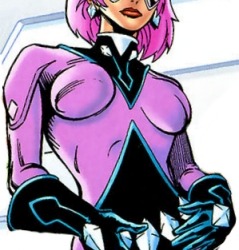
Edit
Rachel Leighton was born in Austin, Texas. She was once a part-time sales clerk at a boutique, but later became a mercenary. In Captain America vol. 1 #319, she reveals to Captain America that she has a brother and that when she was younger was introduced by him to the super-criminal known as the Trapster. In exchange for weaponry that the Trapster provides her with, Leighton suggests that in return she prostitutes herself to the criminal. One of the members of the original Serpent Society,[1] Diamondback was a seductively sly woman with expertise in hand-to-hand combat, being trained by Anaconda at Taskmaster's academy. Her gimmick was that she threw acid-laced or poison-tipped diamonds at her enemies. After her first confrontation with Captain America while on assignment to find MODOK,[2] she was instantly smitten. Diamondback was assigned to take Captain America into custody from the Porcupine, but was reluctant to attack, concentrating her efforts on Porcupine instead.[3] She later attempted to form a partnership with Captain America to locate the Scourge of the Underworld.[4]
Viper staged a coup of the Serpent Society, causing several of her underlings to infiltrate as new members and setting Viper up to take over by force. Diamondback and their current leader Sidewinder escaped, recruiting Captain America's allies to rescue the Serpents who were still loyal to Sidewinder.[5] After a fierce battle, in which Viper was defeated, Sidewinder abandoned the Serpent Society. Diamondback stayed on for a while under the new leader, Cobra.
Rachel was later revealed to have resigned from the Serpent Society, and somehow temporarily switched bodies with the X-Man Dazzler. This led, in part, to a confrontation between the Serpent Society and the X-Men.[6] Diamondback later alerted Captain America to the Bloodstone Hunt.[7] She aided Captain America in combat with Batroc, Machete, Zaran, and Baron Helmut Zemo.[8] She also encountered Crossbones for the first time.[9] Diamondback later accompanied Captain America to the Red Skull's Skullhouse.[10]
Diamondback and Captain America eventually went on their first date, aided by Rachel's friends in the Serpent Society, Asp, Black Mamba, and Anaconda.[11] She then battled the Black Widow, and acquired a new costume.[12] Diamondback was eventually put on trial by the Serpent Society for her consorting with the enemy (most of the Society assuming, incorrectly, that Diamondback had betrayed their secrets to Captain America) and found guilty for her actions, and almost executed.[13] She escaped with Captain America and Paladin's help, and later hired Paladin to help get revenge on the Serpent Society.[14] Along with her best friends Black Mamba and Asp, she formed "BAD Girls, Inc."[15] After a failed kidnapping attempt from Anaconda, Diamondback was taken aboard Superia's ship, and joined her Femizons under duress.[volume & issue needed] While aboard Superia's ship, she was attacked by the Femizon Snapdragon, of whom Diamondback developed a phobia.[volume & issue needed] After being rescued and then being used as a test subject by the Red Skull to see if the blood packets that Crossbones brought was really Captain America's blood, the super-soldier serum enhanced Diamondback tracked down and confronted Snapdragon, who died in the fight.[volume & issue needed]
Later, there was a glitch discovered in the super-soldier serum that Cap was suffering from and Diamondback went to Superia in hopes for a cure. Using her as a test subject, there was a 50/50 chance that the cure would either work or kill Diamondback. As an added stipulation, if the test was successful, Diamondback had to serve Superia as the second Snapdragon. The experiment was a success, but she later got out of this deal when Superia was killed.[volume & issue needed]
BAD Girls disbanded after that. Some time later, Diamondback was infected with "mind-control nanoprobes" by Baron Zemo. Diamondback suffered extensive neurological damage from the experience and spent an extended period of time recovering in S.H.I.E.L.D. care.[volume & issue needed]
BAD Girls, Inc. reappeared in Cable & Deadpool, with the original lineup intact.[16]
Rachel's brother Danny is also known as Cutthroat. It was Danny and another of her brothers, Ricky, who originally fell in with a gang led by a man known as "Bing." Yearning to be included, she approached Bing alone. Upon claiming she would do anything to join the gang, Rachel was beaten and possibly raped by Bing, who years later became Crossbones, kidnapped her, starved her and abused her until she agreed, with ulterior motive, to steal packages of Captain America's blood from Avengers Mansion. Bing/Crossbones murdered Danny/Cutthroat, who was attempting to replace him as aid to the Red Skull, and also killed Rachel's third brother, Willy, when, despite being crippled in the military, he sought revenge by rifle for the brutality inflicted on his sister soon after she was originally mistreated.[volume & issue needed]
Diamondback later turned up along with Asp and Black Mamba during the "Civil War" as a member of the Secret Avengers.[17] She took part in the final battle of the "war", but did not accept the offer of amnesty that came with Captain America's surrender. Later Diamondback and the other BAD Girls were captured by the Mighty Avengers in a New York City street mall.
Diamondback appears in Camp Hammond, as an official recruit for the Initiative, along with Ant-Man, Crusader, Melee, Geldoff, Dragon Lord, Geiger, and Red Nine. All of them were defeated by K.I.A., a rogue clone of Michael Van Patrick.[18] She later joined other members of the Inititative in battling the Skrulls in New York during the Secret Invasion storyline.[volume & issue needed]
When Norman Osborn assumes control of the Initiative during the "Dark Reign" storyline, Diamondback agrees to work for him.[19] Diamondback is revealed as a member of the Initiative's new team for the state of Delaware, the Women Warriors.[20] After the Constrictor saves her life from a crashing plane, the two begin a sexual relationship.[21] However, Constrictor discovers that she is secretly working for Gauntlet's "Avengers Resistance".[22] Constrictor decides not to say anything but worries about what would happen if she were found out. Both Diamondback and Constrictor are part of the invasion of Asgard. Diamondback tries to contact the Resistance but cannot get through. She debates whether or not to help Thor when Osborn and several others gang up on him. When Maria Hill comes to Thor's defense by firing a rocket launcher at Osborn's men, Diamondback adds to the explosion by dropping some explosive diamonds. Constrictor saves her and the two argue about her reckless behavior. They witness Sentry killing Ares and Diamondback sees Steve Rogers entering the battlefield.[23] As the Avengers begin to turn the tide in the battle, Diamondback tries to get Steve Rogers's attention and make sure he knows she and Constrictor are on his side. Constrictor misinterprets her actions and think she's abandoning him. She turns to find him but at the same time Sentry attacks Asgard's foundations on Osborn's orders. As Rachel and Constrictor reach out to each other, Asgard falls to the ground.[24] Rachel is dug out by Steve Rogers. Constrictor sees this and thinking Rachel does not love him, flees the scene with Taskmaster. After Osborn's defeat, Rachel attends a party at Avengers Tower where Rogers asks her to coordinate the remaining Fifty State teams. She tells him she will consider it.[25]
Later, Rachel is shown working as an agent of S.H.I.E.L.D. and sporting a new costume.[26]
As part of the 2015-2017 All-New, All-Different Marvel branding, Captain America learns of Viper's plans with the Serpent Society, who are now operating under the new name of Serpent Solutions. He visits the retired mercenary Diamondback for information on the group. Their meeting is interrupted by Cottonmouth, Black Racer, and Copperhead. During the ensuing battle, Black Racer stabs Diamondback in the gut. After Captain America defeats the three villains, he rushed to Diamondback's aid. Diamondback immediately betrays Captain America, revealing herself to be a member of the Serpent Society once again, and Captain America is taken prisoner and brought to the Serpent Society's lair.[27] This leads to a confrontation between the Society and Captain America, Joaquin Torres, Misty Knight, and Demolition Man, during which Diamondback turns against Viper and helps the heroes defeat the Society.[28]
Diamondback is next seen working with her close friends Domino and Outlaw as mercenaries
8 notes
·
View notes
Text
Glorious, Before the Burden - The Mourning ~ 13
Waking up after seeing Loki with Sylvie - adult Sylvie - I lay in bed and stared at my ceiling trying to understand. What - where were they? The morning dawned as I tried to make sense out of the senseless and I gave up. LISTENING was how I was supposed to get my magic in line to grow and evolve, not forcing myself to make things work into a box of logic when the logic was nowhere near where I was.
I got out of bed, letting it right itself as I dressed and fixed my hair - making up a schedule for my day. A trip to the village was in order since my cupboards were getting bare, my books were growing tiresome, and I needed to find some inspiration for what I should do next. As I stood in the kitchen getting a glass of water, staring out at my garden - I watched as once again a group of people wandered in to trample it - only this time they appeared out of the same type of doorway that Sylvie had.
Sighing deeply, I opened my door and stood with my arms crossed. The man with the crooked nose and white hair I’d seen Loki interacting with was among the barbarians ruining my garden.
“Do you MIND?” Stepping out onto the pathway, I raised my hand and they parted like water. “Do keep to the path, I’d rather not have to replant the damn garden every time one of your groups stomps through to demand an audience.”
He stepped forward, the leader clearly, and offered his hand. “I apologize, Miss -” I stared at his hand and then back at his face. Awkward silence prevailed and he dropped the hand. “You’re not as hospitable as I was expecting from the files. I guess that’s understandable given your current status.”
“Pardon?” Staring at him, he realized that he’d only made matters worse for himself. “Who precisely are you? All of you?”
“Right, sorry again.” He looked as if he might wish that anyone else had been in his place. “My name is Mobius M. Mobius, I’m an agent of the Time Variance Authority.”
“The Time Variance Authority?” I sounded as unimpressed as I felt. “And what authority does this particular agency have, AGENT Mobius?”
“I’m glad you asked that, Miss -” Again lacking, so he rushed on. “We’re tasked with keeping the Sacred Timeline intact and on track.”
“The Sacred Timeline, you say.” My eyebrow couldn’t be stopped from rising. “There are infinite timelines, Agent Mobius, which one of these infinite timelines has been deemed ‘sacred’?” He stared at me. “Why are you here, on my doorstep, while your fellows are tearing apart my garden?”
“Loki,” one word, one name, and yet it weighed more than the entire universe. “Your husband, well a variant of your husband - he’s killing our people.”
“And?” Not really my problem, given that he wasn’t MY Loki. My Loki was locked away on Asgard and I was trapped here. “What precisely do you want from me?”
“Information.” I laughed. “He has to be stopped, Miss -”
“First of all, Agent Mobius, I am not a ‘miss’.” I sighed. “I’ve been married for a very long time to my husband, and while we are not physically together, I can assure you we are still VERY MUCH MARRIED.” He swallowed so hard that I felt sure that his people could hear him even as they muttered amongst themselves. “Second of all, I cannot see why you would imagine that I would give information to such a ridiculous outfit such as an agency that is so fanciful as yours. Honestly, a Sacred Timeline? Have you no understanding whatsoever of how anything works?”
He opened his mouth to speak, but I raised my hand and whatever he hoped to say caught in his throat. And as I stared into his eyes I saw something terribly tragic - this person had no idea who he truly was, none at all. Taking the hand I’d raised to stop him from uttering more nonsense, I touched his hand and saw that not only did he hope to gain my trust and cooperation in bringing this dangerous version of my husband to heel, but he also wished to keep me safe - even if he wasn’t entirely sure what I was in danger from at least not on the surface level of his current state.
Someone, a young woman with a rigid disposition and a darkness within her that was unmatched by the man before me, planned a very different way to correct the problem the Variant - that’s what they called the Loki, and others like my husband who strayed from their proper place in time - had created on their Sacred Timeline. A plot that the man before me had disagreed with so vocally that he’d been reset, but not well enough to get the urge to bring me onboard in his quest to fix the issue in his own way. How horrible, I thought, as I felt the confusion and betrayal he’d felt as a person he thought of as a friend had violated that trust to remove a piece of him - and how truly horrific that he didn’t know that his entire existence was built on a lie.
Removing my hand, I also released him from the silence I’d forced on him.
“Of course I understand -” he sighed, “What should I call you?” He smiled awkwardly and I returned it with a smile of my own. Why not, since he would lose this memory as well?
“Sigyn,” giving him my name was easy enough, but knowing that Loki - any version of him - AND Sylvie were running from people like these made my blood run cold. “You can call me Sigyn.”
Mobius didn’t stay much longer. He even managed to convince the troop he came with to stand outside the garden. And he found that I was true to my word, I would not give him information on my husband - Variant or not.
Before he, and the others, left - I removed the visit from their memories and the TempPad. Watching him disappear through the doorway I’d seen Sylvie disappear behind so many times in my childhood, I wondered what would become of him - this Mobius M. Mobius? Would he ever learn the truth about the lies that built his world and purpose? And how would he take it when he found out that the ONE person he thought he could trust the most, was the one he shouldn’t trust at all?
My schedule was thrown off by the visit from the Time Variance Authority. And using powers that I hadn’t used before, but somehow knew I had access to - LISTENING to my intuition, to what felt right instead of what I would normally do - had reminded me that I hadn’t broken my fast. Hungry and a touch tired, I went back to the kitchen to pick up where I’d left off when I witnessed my visitors’ arrival.
Sitting at the table, my cell phone next to me, eating absently while I contemplated what I saw through Mobius’ ruined memories. His companion, a superior to him - a judge named Ravonna - had told him she planned on erasing parts of Loki’s timeline, the parts she deemed most likely to set him on the path that would lead to his homicidal rampage. He’d argued against this course, reminding her that they still had no idea where this Variant had come from, and that meant that they hadn’t a clue as to which parts of the timeline should be wiped to be effective. The coldness in her face should have warned him, but he didn’t know her, not really. He simply thought he did, because of the process that created him.
The part she wishes to erase was me, Sigyn, the wife. Clearly erasing the most emotionally charged part of his timeline would work to break him - dull the blade and he’d be easier to prune. Mobius had argued that by that logic she should erase Frigga as well, or Thor - but Ravonna shook her head.
“No,” her smile grew in an almost reptilian way. “If you look through the files, if you WATCH it - what Loki feels for Sigyn, it goes far beyond simple affection or love, Mobius. Remove her from the equation, take her away and he has NOTHING to search for, nothing to yearn for, nothing to reach and grasp for - he’ll beg to be pruned.”
I’d felt sick, the way she’d considered it - as if breaking him apart and ripping me away from him was a game. As if watching him - I knew that these files weren’t simply written, that they were visual - she watched him in his cell in Asgard, watched as he saw the wraith of me visit him and how he felt tortured by it. And I knew she ENJOYED it. Unlike Frigga, who I felt did only what Odin asked, Ravonna wanted to see Loki in agony and begging for it to end so she could order it.
The only thing that gave me strength was the knowledge that she obviously didn’t KNOW Loki. Removing me from a file wouldn’t convince him that I was gone or break him - that equating that with the pain he was feeling in his cell in Asgard was the mistake of a sadistic amateur. If anything, removing me would make him MORE thirsty for a path to find out WHY I was removed and WHERE I was. Ravonna had done nothing to make her tiny little hope bear fruit, instead she made it more likely to go in the opposite direction.
If only I knew how Sylvie fit into the situation -
I set off for the village after my breakfast. Content that the weather was perfect for the walk, and that I could easily find everything I needed within walking distance of my home.
Books first, the small shop was owned by the second person to befriend me after Michael. A lovely young woman named Caroline who quickly learned the types of books that I most enjoyed and would tuck a few behind the counter for me, even though she knew I’d still wander the stacks and pluck a few more to add to the pile.
“You’re up and out early this morning, Margaret,” her smile was open and warm. “I had a feeling you’d be around today.” Reaching under the counter, she pulled out four books and set the on the counter. “I’ll keep them here for you while you browse.”
Shaking my head, my smile came easily as I roamed the aisles, gaze dancing across the spines of the books as I looked for anything that stood out and caught my attention. While I shopped, Caroline and I chatted, the shop being small enough that we didn’t have to raise our voices even when I was at the furthest point from the till. She asked about Micheal and I assured her that he was well, telling her that we’d spent the day before together.
“He dotes on you,” she was grinning as I joined her at the counter to pay. “We’re all happy you came home to keep him company. You keep him young.” My smile faltered, a reminder that I’d be leaving once I learned how to rejoin Loki - leaving Michael alone again.
“He’s incredibly kind,” I agreed, paying for my books. “And I’m glad I came home too.”
The rest of my shopping trip was much the same. Friendly reminders of how thankful everyone was that I’d “returned” to the family fold so Michael wasn’t alone any longer. The reminder of what I would be leaving was starting to cause me pinpricks of pain - but the piercing ache of being apart from my husband was overpowering. I could always visit Michael, it wasn’t as if I couldn’t come back.
At the cottage, once everything was put in its place, I chose not to return to the laptop and instead went to the garden to inspect the damage caused by Mobius and his group. A few bushes weren’t quite as bushy as they should be, several of the flower beds were smashed with boot prints, and the grass had divots that showed dirt where green should be.
Sighing heavily, I sat down on the bench and closed my eyes. The air was cool and the sun was trying to shine through a hazy cloud cover. A slight breeze ruffled my hair as I let the calm of my garden - damaged though it was - soothe my frayed nerves.
Perhaps it was the breeze. Maybe it was the scent of apples that blew in from somewhere. It could have been the hint of galbanum that tickled my nose. Whatever it was, somehow I wasn’t in the garden anymore - instead I was on a train unlike any train I’d ever been on - and there was Loki sitting across from Sylvie.
2 notes
·
View notes
Text
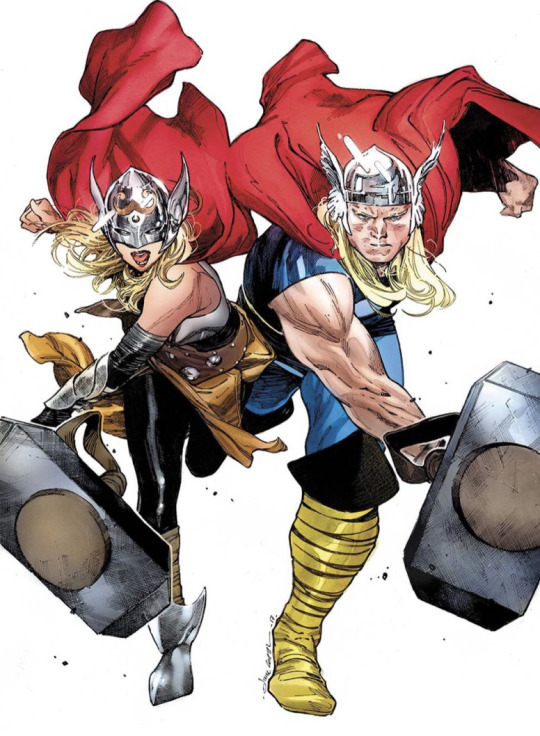
Jason Aaron has evolved into one of the most creatively rich and productive writers at Marvel, and frankly in the entire Comic Book Landscape. His stories are saturated with texture and steeped in foundational knowledge as well as character growth. From Wolverine to the Hulk, and even Doctor Strange, Jason Aaron has taken every character he’s touched at Marvel and reshaped them into something so much more!
Well, over the past eight + years, Jason Aaron has done the same thing with the God of Thunder. So, to help new readers jumping deep into the MCU or to those that have never taken the intense plunge into THOR, here is a thorough reading order for all related Jason Aaron THOR titles dating back to 2012. This should keep you current!

Plus, if you can hang on until the end, I’ve attached single issue reviews, as well as series reviews, for tons of other Jason Aaron titles from THE GODDAMNED, to SCALPED, and other amazing Marvel Heroes in between! Thanks for the read and I hope you enjoy it.

And if you’re all caught up on Aaron’s THOR, check out my latest review of THOR #5 by Donny Cates HERE, as well as links to get your hands on current THOR issues and trades.

Thor: God Of Thunder (2012-2015)

Thor: God Of Thunder Volume 1: The God Butcher (#1-5)
A trail of blood threatens to consume Thor’s past, present, and future! Throughout the ages, gods have been vanishing, their mortal worshipers left in chaos. The only hope for these ravaged worlds is for Thor to unravel the gruesome mystery of the God Butcher! In the distant past, the Thunder God discovers a forgotten cave that echoes with the cries of tortured gods – and is shocked to find himself among them! In the present, Thor follows the bloody wake of murdered gods across the depths of space. And thousands of years from now, the last god-king of a ruined Asgard makes his final stand against the God Butcher’s berserker legions. As three Thors from three eras race to stop the God Butcher, the full extent of his vicious scheme takes terrifying shape!
Click HERE to grab this trade.
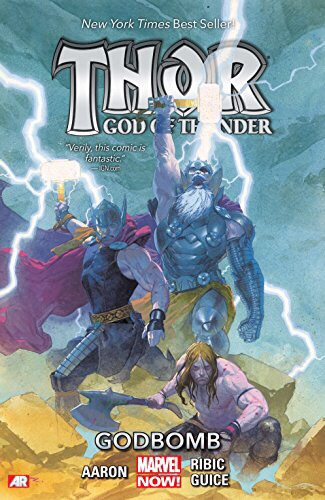
Thor: God Of Thunder Volume 2: Godbomb (#6-11)
Somewhere at the end of the time, all the gods of the universe are enslaved, working to build a machine that will forever change the face of creation. What is the Godbomb? And what can Thor do to stop it? While Gorr’s master plan continues to unfold, all hope for divinity is lost when Thor finds himself in chains alongside his fellow gods. And even as Gorr’s dark origin is revealed, along with the truth behind his bloody quest to butcher the gods, three time-bending Thors unite to lead an army of slave gods in the fight against Gorr. But will it all be for naught as the clock ticks down and the massive Godbomb is triggered at last? And after the dust clears, what will be left of the universe’s deities?
Click HERE to grab this trade.

Thor: God Of Thunder Volume 3: The Accursed (#12-18)
It’s the bloody return of Malekith the Accursed! The former lord of the Dark Elves escapes his otherworldly prison, and the chase is on across the Nine Realms to capture him! Thor finds new allies to join his Wild Hunt: A Dark Elf sorceress! A gun-toting Light Elf! A gargantuan Mountain Giant! A dwarf who loves dynamite! And a particularly surly troll! But when one teammate falls, will it mean war for all Nine Realms? And as a traitor within the group strikes and Thor prepares to take drastic measures, Malekith stages his final bloody raid – on Earth! Plus: What does it mean to walk the Earth as a god? What does Thor do when he’s not out saving the world with the Avengers? It’s the return of Thor’s longtime love interest, Dr. Jane Foster!
Click HERE to grab this trade.
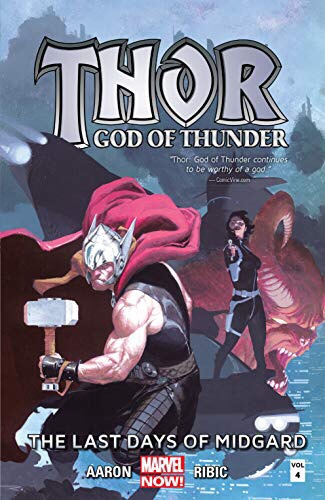
Thor: God Of Thunder Volume 4: The Last Days of Midgard (#19-25)
Thor battles to save Earth, but who can he fight when the planet itself is dying? S.H.I.E.L.D. Agent Roz Solomon has a suggestion: the nefarious energy company Roxxon and its ruthless new CE O, “the Minotaur!” Has Thor met his match in the form of a multinational supercorporation? Meanwhile, millennia from now, King Thor and his granddaughters, the Warriors of Thunder, face a very different battle to save what remains of the earth – from Galactus! But even if Thor wins, is the Earth still doomed? In the present, Thor makes a final stand against the Minotaur, Ulik the Troll, and Roxxon’s forces – but not even a god can save everyone. Plus: Young Thor vs. Frost Giants! The untold origin of Malekith! And King Thor’s granddaughters discover the startling secret of his Original Sin!
Click HERE to grab this trade.
Original Sin (2014)
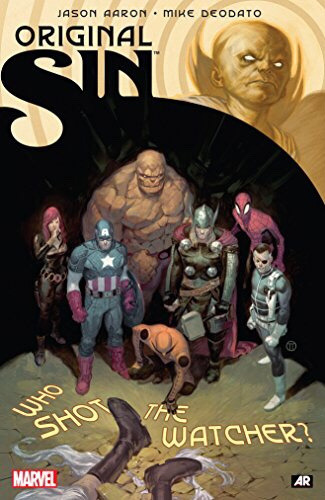
Original Sin #0-8 (2014)
Who shot the Watcher? Uatu, the mysterious space-god who’s been watching mankind from the moon for as long as we can remember…is dead. Thus begins the greatest murder mystery in Marvel history! As Nick Fury leads the heroes of the Marvel Universe in an investigation, other forces are marshaling and other questions are arising. Why is Black Panther gathering a secret team of his own, including Emma Frost, the Punisher, and Dr. Strange? Who is the Unseen? What was stolen from the Watcher’s lair? Fury’s cosmic manhunt leads to the far corners of the universe and beyond, but just when the Avengers think they’ve cornered their murderer…everything explodes, unleashing the Marvel Universe’s greatest secrets and rocking the heroes to their core! What did the Watcher see? What was the Original Sin?
Click HERE to grab this trade.

Original Sin: Thor & Loki – The Tenth Realm (Original Sin #5.1-5.5 2014)
Thanks to the events of Original Sin, the deepest secret of the Nine Realms has been revealed: namely, the existence of a Tenth Realm! Now, Thor and Loki must embark on a quest to discover this strange new world – and to discover the sister that Thor never knew he had: Angela! But can Loki be trusted? And will brother and sister murder each other before the truth comes out?
Click HERE to grab this trade.
Thor (2014-2015)

Thor Volume 1: The Goddess Of Thunder (#1-5)
Mjolnir lies on the moon, unable to be lifted! Something dark has befallen the God of Thunder, leaving him unworthy for the first time ever! But when Frost Giants invade Earth, the hammer will be lifted — and a mysterious woman will be transformed into an all-new version of the mighty Thor! Who is this new Goddess of Thunder? Not even Odin knows, but she may be Earth’s only hope against the Frost Giants! Get ready for a Thor like you’ve never seen before, as this all-new heroine takes Midgard by storm! Plus: The Odinson clearly doesn’t like that someone else is holding his hammer — it’s Thor vs. Thor! And Odin, desperate to see Mjolnir returned, will call on some very dangerous, very unexpected allies. It’s a bold new chapter in the storied history of Thor!
Click HERE to grab this trade.
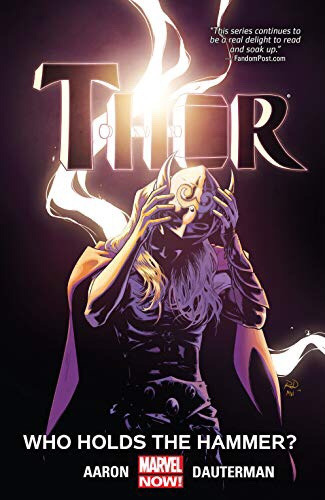
Thor Volume 2: Who Holds The Hammer (#6-8, Annual #1)
Who is the new Thor? That’s the question on everyone’s lips. Most especially the original Thor! And now he starts to narrow down the list of suspects. Meanwhile, tensions continue to flare between the All-Mother and All-Father, Malekith the Dark Elf forges his most dangerous pact yet, and the new Thor prepares to face her greatest challenge: the unstoppable machine of death and destruction that is…the Destroyer! As the battle for the hammer Mjolnir rages on, an unexpected character makes a shocking return – and the new Thor’s identity is revealed at last!
Click HERE to grab this trade.

Secret Wars (2015-2016)

Thors: Secret Wars Battleworld (Thors #1-4 2015-2016)
The Thors of every domain, together in one book! As cosmic cops! Whenever there’s trouble on Battleworld, the Thors answer the call. But a string of mysterious murders leaves some of them asking questions that may unravel all of reality! A hard-hitting Marvel Comics police drama. With hammers. Lots and lots of hammers.
Click HERE to grab this trade.
SIDE NOTE: Check out the entire Secret Wars Event HERE. Trust me; you’ll love it!!!!!
The Mighty Thor (2016-2018)

The Mighty Thor Volume 1: Thunder In Her Veins (#1-5)
Dr. Jane Foster is the Goddess of Thunder -and it’s killing her. Her enemies are many as Asgard descends further into chaos, and unrest threatens to spread throughout the Ten Realms. Yet she wages her greatest battle against a far more personal foe: the cancer killing her mortal form. When Loki steps back into Thor’s life, will it ease her troubles or only add to her pain? There’s no such question about Malekith as he continues to fan the flames of a looming War of Realms – when he isn’t wedding planning, that is! And as Asgard is torn apart, the skies will shake in one of the bloodiest battles of all time: It’s Thor vs. Odin like never before!
Click HERE to grab this trade.

The Mighty Thor Volume 2: Lords Of Midgard (#6-12)
The legend continues with Thors new and old! Loki spins a special ages-old tale of a young Odinson in action against a hulking great enemy. You wouldn’t like this Viking when he’s angry! But what incredible impact will this yarn from the past have on the present? Prepare for corporate espionage, Marvel-style, as some of the world’s most powerful and evil conglomerates go to war – with Thor caught in the middle! And as if Roxxon and the rest aren’t enough trouble, Jane Foster must contend with a new enemy: S.H.I.E.L.D.! Worse still, somehow millions of lives will depend on the God of Thunder saving Roxxon’s evil executive, Dario Agger!
Click HERE to grab this trade.
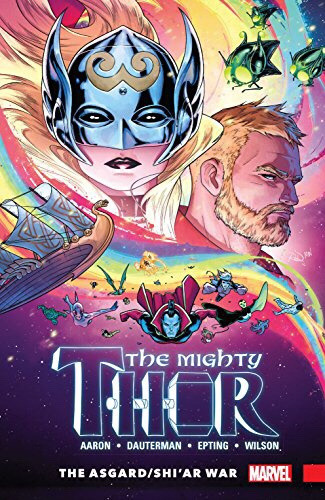
The Mighty Thor Volume 3: The Asgard/Shi-Ar War (#13-19)
As the War of the Realms rages on, the only way to defeat Malekith is with a united front – and it’s up to Thor to bring the many races together! Now heroes from across the ten worlds – including Lady Sif and Angela – unite under Thor’s command to form a new League of Realms, with the sole mission of bringing this conflict to an end! And their first mission is to infiltrate Dark- Elf-occupied territory! But when the war spreads to every branch of the World Tree, the League’s road to peace is fraught with challenges they hadn’t anticipated. To stand against the heroic allies, Malekith forms a wicked union of his own, calling on Loki and the all-new Kurse to take down Thor and her band of heroes!
Click HERE to grab this trade.

Unworthy Thor TPB (#1-5)
Unfit to lift his hammer, with another now wielding the power of Thor, the Odinson’s desperate quest to regain his worthiness takes him out into the cosmos – where he’s learned of the existence of a mysterious other Mjolnir! This weapon of ultimate power, a relic from a dead universe, is the key to the Odinson’s redemption – but some of the greatest villains of the Marvel Universe are anxious to get their hands on it as well. And when the Realm of Old Asgard vanishes, the Odinson’s hopes might go with it – unless good tidings from Beta Ray Bill offer fresh hope! Can the Odinson reclaim his honor, or will the power of thunder be wielded for evil? Let the battle for the hammer commence!
Click HERE to grab this trade.

The Mighty Thor Volume 4: The War Thor (#20-23, Generations: Unworthy Thor And Mighty Thor #1)
Who is the War Thor? The Ultimate Universe’s Thor died defending the Multiverse, but his hammer remains. Who wields it now? Ponder that question along with Jane Foster, the Mighty Thor, as she faces the Ultimate team-up! War is coming to the Ten Realms -and when the Queen of Cinders sets them ablaze, even the combined might of not one, not two, but three Thors may not be enough to put out the flames! Meanwhile, Malekith’s army grows, and the looming conflict reaches Asgard’s doorstep! But even the fire of Muspelheim pales beside the fury of the War Thor -and with his thunder comes vengeance! Plus: Generations collide as Jane and a young Odinson face an Apocalyptic encounter in ancient Egypt!
Click HERE to grab this trade.
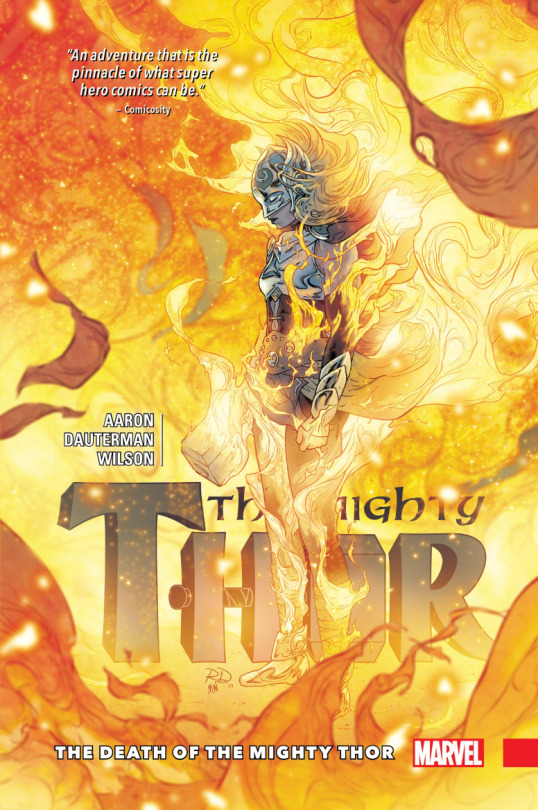
The Mighty Thor Volume 5: The Death Of The Mighty Thor (#700-706, Mighty Thor At The Gates Of Valhalla #1)
Marvel Legacy hits Asgard with a bang, with…the death of the Mighty Thor! The final judgment comes as the Mangog arrives. The War Thor will meet the beast head-on, but even the blood-thirst of this Ultimate hammer-wielder may pale in comparison to the Mangog’s might! The battle rages even as Jane Foster’s cancer takes a turn for the worse, and she might not have to wait for the final judgment at all. The clock is ticking, the War of the Realms is spreading, and Mjolnir cannot save her this time. Can even the legendary Hercules help avert disaster? It’s the beginning of the end – one that will lead to the most dramatic return in the Marvel Universe!
Click HERE to grab this trade.
Thor (2018-2019)
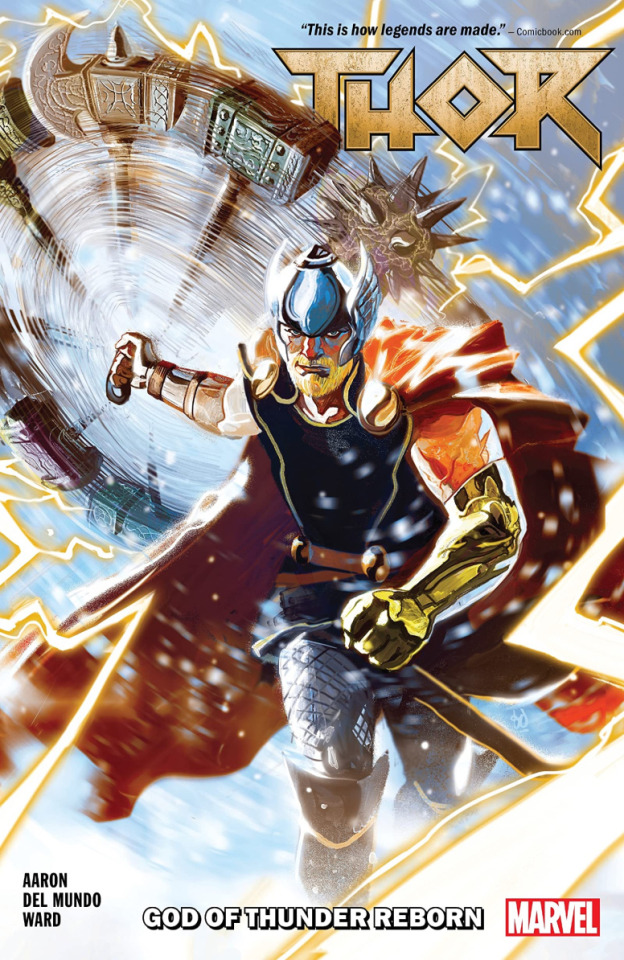
Thor Vol. 1: God Of Thunder Reborn (#1-6)
Thor Odinson has regained his mantle – and with it, a wild new world of trouble on his mighty hands! The artifacts of Asgard have been scattered across the Earth, and to reclaim them, Thor will have to face some ugly truths. Like the production cost on hundreds of new hammers! And the Thunder God is going to need every last one of them if he’s going to stop the unstoppable Juggernaut. Jason Aaron takes the Prince of Asgard in a whole new direction with YOUNG GUN artist Mike Del Mundo joining him at the helm! And don’t miss the latest chapter of the King Thor saga with acclaimed BLACK BOLT artist Christian Ward, as the Thor of the far future encounters an old friend who’s undergone some startling changes.
Click HERE to grab this trade.
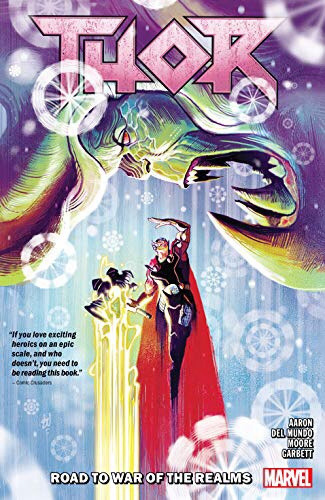
Thor Vol 2: Road To War Of The Realms (#7-11)
Jason Aaron’s epic THOR run continues! Part the mists of time and peer into the distant past – for a tale of a young Odinson from the Viking age! Every time Thor travels to the mortal land of Midgard, he finds all the mead, battle and romance that a young god could possibly want. But he still can’t figure out how to prove himself worthy of the mighty hammer Mjolnir. Now Odin is determined to keep his son away from Midgard for good – and young Loki knows just the way to do it! Then, in the modern-day, Thor is held prisoner by the fearsome warriors of the Tenth Realm: Heven! Can even the intervention of Valkyrie and Thor’s deadly sister Angela help Thor escape the inescapable prison of angels?
Click HERE to grab this trade.
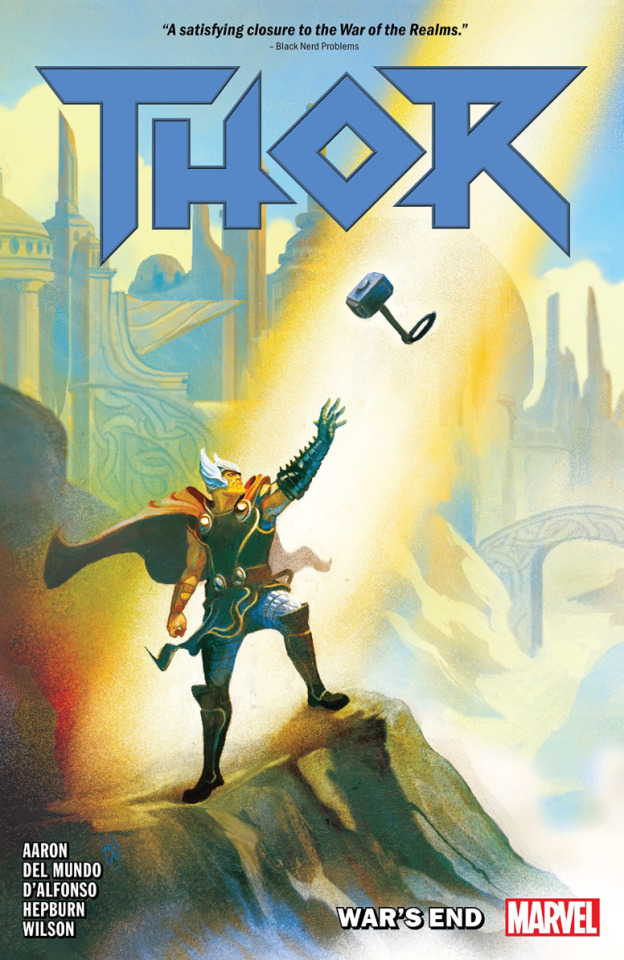
Thor Vol 3: War’s End (#12-16)
After years of Malekith’s plotting, the War of the Realms is raging full force – and for Loki, that means it’s time for a family reunion! Fatherly love is not something that the God of Lies is terribly familiar. Having been adopted by Odin as an infant and raised in the Asgardian royal family, Loki never had a chance to bond with his birth people – the fearsome Frost Giants. But now, the Giants have invaded New York City as part of Malekith’s war on Midgard. And you’d think that Loki would take the opportunity to find some quality time to spend with dear old deadly Dad! And he will. But not in the way you’d think…
Click HERE to grab this trade.
War of the Realms

War of the Realms (2019)
THE WAR OF THE REALMS is upon us! Malekith, king of the Dark Elves, has been conquering the Ten Realms and now has his sights set on the last one: Earth. And with armies of Frost Giants, Fire Goblins, trolls, angel warriors, Roxxon corporate soldiers, the Enchantress and the prince of lies himself, Loki, at his side, Malekith may just succeed. Asgardia is no more, Old Asgard is in ruins, and the majority of Asgardians are refugees on Earth. Now Thor and Earth’s heroes — including the Avengers, the Fantastic Four, and even such unlikely allies as Venom and Punisher — are all that stand in Malekith’s way! It’s an event five years in the making as the MIGHTY THOR creative team of writer Jason Aaron, artist Russell Dauterman and colorist Matthew Wilson reunite to save the Ten Realms!
Click HERE to grab this trade.
After The War…

King Thor (2019-2020)
Superstars Jason Aaron & Esad Ribic conclude their epic Thor story! The creators of the legendary THOR: GOD OF THUNDER series that kicked off one of the most epic runs in Marvel history are back together for one last ride with the almighty Lord of Asgard! Seven years ago, Jason and Esad introduced the Thor of the far future, All-Father of a broken realm and a dying universe, as he stood in battle against the Butcher of Gods, wielder of All-Black the Necrosword. Now that nefarious blade has returned, in the hands of Thor’s all-time greatest enemy – his brother, Loki – for one final, cataclysmic showdown. Behold the book no comics fan should miss – the celebration of the end of a truly marvelous era.
Click HERE to grab this trade.
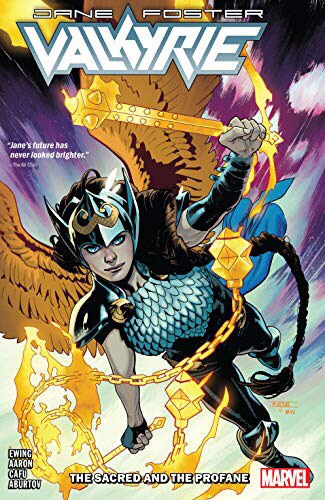
Valkyrie: Jane Foster Volume 1: The Sacred And The Profane (#1-5)
Jane Foster is back! For years, you knew her as Dr. Jane Foster, one of Thor Odinson’s most steadfast companions. Then you knew her as Thor, Goddess of Thunder, who took up the mantle when no other hero was worthy. Now Jane takes on a new role as Valkyrie, guide, and ferrywoman to the dead! But her days of battle are far from over – especially when the Marvel Universe’s deadliest shot gets his hands on the sword of a god! With the Asgardian weapon Dragonfang, Bullseye has the power to kill a deity in a single stroke – and he’s about to prove it. Jane must learn a hard lesson: Not every death can be prevented. But who’s next on Bullseye’s list – and what is the assassin really after?
Click HERE to grab this trade.

Valkyrie: Jane Foster Volume 2: At The End Of All Things (#6-10)
Jane Foster has been many things in her life, including the heroic hammer wielder known as Thor! Recently, Jane became the Valkyrie, guardian, and protector of the Norse dead, and she’s still finding her way in this new stage of her life. But now, Jane must return to the role she knows best – that of a medical doctor – when a supernatural medical emergency rears its head! Jane teams with Doctor Strange, Sorcerer (and Surgeon) Supreme; the tough-as-nails Night Nurse; Excalibur-wielding Dr. Faiza Hussain and more Marvel medics to crack a case that will give readers heart palpitations! Heroes of medicine will unite – but are they all about to become doctors to the dead?!
As of July 2020, it’s not released yet but it can be PRE-ORDERED
Click HERE to grab this trade.

Valkyrie: Jane Foster Vol. 3 (#11-15)
She’s faced the Marvel Universe’s deadliest assassin – armed with the sword of a god – and won. She took the Grim Reaper straight to his eternal reward. She’s come face-to-face with Death herself…in more ways than one…and saved Asgard from a force beyond even Death’s powers. Now Jane Foster – the one and only Valkyrie – embarks on a whole new adventure under the pen of rising star artist Mattia De Iulis! Valkyrie has already journeyed across the Multiverse in her new role…but now Hel awaits her. Along with its prickly rulers. But what does Hel want with Jane Foster? And what does Loki, the god of lies and mischief, have to do with it all? Find out in an exciting and action-packed mystery!
As of July 2020, it’s not released yet but it can be PRE-ORDERED
Click HERE to grab this trade.

BUT WAIT… THAT’S NOT ALL!!!

If you or someone you know loves Jason Aaron’s THOR and is interested in other THOR related titles by Aaron, give the ongoing AVENGERS (2018-Present) title a shot! As of July 2020, there are close to 37 issues and seven trades you can really sink your teeth into.
Click HERE to get your hands on all the current AVENGERS trades!
Interested in more Jason Aaron stories?

Click HERE for a series review of his CONAN THE BARBARIAN run and links to the trades!

Click HERE for a review of INCREDIBLE HULK #1 by Jason Aaron and links to trades and issues in his run!
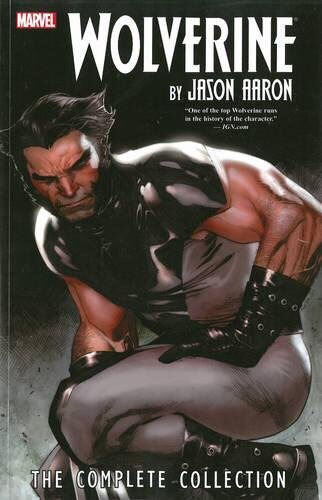
Click HERE for a review of WOLVERINE: WEAPON X #1 by Jason Aaron and links to trades and issues in his run!

Or, click HERE to grab WOLVERINE GOES TO HELL and HERE for related WOLVERINE stories by Jason Aaron!
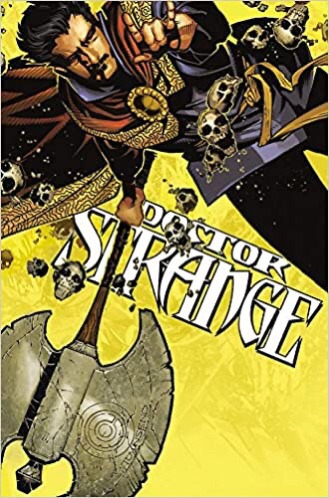
Click HERE to snag trades of Jason Aaron’s DOCTOR STRANGE run too!

Lastly, if you’re simply a huge Jason Aaron fan, check out my series review HERE for THE GODDAMNED with links to get your hands on the trades.

Keep in mind Aaron’s sequel to this series just kicked off NOW called THE GODDAMNED: THE VIRGIN BRIDES #1, which you can grab by clicking HERE!
Additionally, check out my SCALPED series review HERE and my SOUTHERN BASTARDS series review HERE with even more access to these outstanding trades. And finally, if you’re looking for something else to read, check out my Amazon Online Comic Shop HERE. Thank you all again for the read and continued support. I genuinely hope this helped to spike you’re interested in one of the best writers in comics, as well as one of the best Marvel characters on screen and in the comics. Stay safe and stay healthy.





Jason Aaron’s THOR: Reading Order And MORE #thor #janefoster #valkyrie #jasonaaron #odinson #Marvel #marvelcomics #comicbooks #comics Jason Aaron has evolved into one of the most creatively rich and productive writers at Marvel, and frankly in the entire Comic Book Landscape.
#comic books#comics#featured#Jane Foster#jason aaron#king Thor#Midgard#News#Odinson#Preview#Previews#Scalped#Southern Bastards#the goddamned#Thor#unworthy thor#valkyrie#Valkyrie Jane Foster#war of the realms
18 notes
·
View notes
Note
top 5 comics (runs, issues, story arcs, idc)
brina this is such a vague question why.
1. invincible iron man 2015 #13 it hurts so bad
2. angela: queen of hel but like all of it
3. loki: agent of asgard #13
4. iron patriot #5
5. silk (2016) #10
6. any issue of anything where jeanororo hug
1 note
·
View note
Note
If given the chance, how would you rewrite the MCU?
Anon. Anon. Anon.
How wouldn’t I?
I mean - okay, there’s a lot you have to keep the same just for the sake of like, continuity, clarity, and keeping the bones there.
I’d probably keep all the original movies in Phase 1 as they are with only minor tweaks. I’d fix the mess that was Iron Man 2. I’d give Black Widow and Hawkeye a movie of their own to establish their characters. Hmm, I can see that coming after the first Avengers, possibly.
The first Avengers film though, that’s where I would make the first major changes.
Loki’s characterization is a mess and not properly explained in canon. I’d put him more obviously under Thanos’s thumb. I’d fix Cap’s messed up characterization. I wouldn’t have Thor show up when he does because, hey - bifrost issues. We’d see him and Heimdall from Asgard trying to work on that problem and let them find a cogent way to get Thor to earth. So, he’d show up for the final battle and to take Loki home. He’d be the ace in the hole that helps allow the Avengers to assemble and overtake Loki.
Okay, so fix Iron Man 2. I can barely remember it but I know it needs fixing.
Cap 2 I’d leave intact. I might give Hulk a follow-up movie tbh, or rather, probably tie him in to the Black Widow and Hawkeye movie that would follow the first Avengers.
Also put more female heroes front and centre earlier on. And especially WoC.
Big issues arise by the time we get to Age of Ultron. Fix that hot mess of a movie.
Hawkeye doesn’t have a family and a farm. That was weird. Erase that shit. Don’t set up a romance between Nat and Bruce. Don’t -
Look, I mean no disrespect to Tony stans -
Don’t make every problem in the MCU something that was inadvertently caused by Tony. Because like every Iron Man movie involves a villain who felt scorned by him, and then AoU was caused by him messing with the Mind Stone (Bruce too, okay, but Bruce isn’t the one with the narrative trend here) and all the villains in the Spider-Man movies, and then there’s how shit played out in Civil War and -
Okay so fix AoU. Have the Mind Stone literally take on a life of it’s own and don’t fucking make it the fault of Tony’s hubris, okay. Make it more accidental and incidental than it was. Don’t make it something that happened overnight from tinkering.
And for the love of god, make it so that Scarlet Witch and Quicksilver did not sign up to be experimented on, but rather keep their comic origins. They’re Jewish Romani PoC. Give them a narrative that’s authentic to those identities.
I also would not fucking kill off Quicksilver, what the honest fuck?
Actually also don’t just make up a random country and code it a given way and then destroy it. I know it’s an MCU movie and therefore actually needs a giant CGI battle at the end, but okay - Age of Ultron. Stretch that shit out. Make it more clever. Show some more subtle and almost… guerilla tactics from the Avengers, taking down Ultron’s armies? Instead of a single battle in a country we don’t know about and haven’t been told to care about from a narrative standpoint, have Ultron go after their friends and families, have them fight smart and mean but no less visually pleasing to watch. The Avengers don’t have the numbers on Ultron’s army, but they can (and do) recruit Wanda and Maximo and they fight their fight using all their resources - not just their fists.
Okay so let’s move on.
iron Man 3 was great, but the whole bit with Pepper being kidnapped? Not that into it, personally. Also not into her getting powers and then getting them taken away. There was a lot to love about that movie, but so many Iron Man movies tease at this idea of Tony wanting to retire, or getting out, and they need to just back off that and let him own his heroism. That movie navigates so much so well so let it be.
Okay -
Thor 2? Don’t fucking kill Thor’s mom. Friga deserves better. Stop motivating male characters by killing women. Let Loki and Thor come together by Friga being injured, by their dad dying, by a desire to bring their mother joy - whatever. Just - don’t kill her. I’m still pissed about how much they take from Thor over time.
I’d keep Cap 2 the same, and the only changes I’d make to GotG would be -
Okay wait actually. There are huge glaring issues with that movie. Gamora is poised to be the hero of these movies and finds herself as the damsel in distress or incapable whenever the narrative needs her to be. I fucking hate it. Let her shine more. Show instead of tell. Let each character develop in their own right rather than dropping some random backstory notes in expository dialogue. Build up to the notion that it’s super weird Quill can hold the Stone and actually like… acknowledge it in the movie. You can keep the story basically the same but fix things with Gamora’s narrative, please please please.
Okay Ant-Man is great. There’s a huge narrative issue within the entire MCU with how they exclude Janet Van-Dyne though, and how she isn’t introduced until now even though she should be a fundamental member of the Avengers. I would almost like, at some point in Phase 1-3, a movie with Janet at the helm, possibly (to keep their timeline intact), her working with Peggy, working with SHIELD, with a young Fury or something, and laying the groundwork for the Avengers. A lot of what Captain Marvel eventually did, but situated fully on earth, and coming much sooner in the MCU itself.
Civil War was a hot mess. They needed to actually explain and detail both sides and the problems with them. It functioned amazing as an introduction to Black Panther and I love it for that, but it wasn’t a Cap movie, not really, and I’m bitter about it. This movie should have focused around the Black Panther, Cap, Bucky narrative, and dropped the whole Civil War with the other Avengers stuff entirely.
Actually - Civil War needs to be either an entirely separate movie on its own or else… drop it. Deal with it differently. That airport fight was an embarrassment. Let the Avengers break down during Cap 3 if you need do, but make it more interpersonal and tense, and less throwing punches and locking each other up. Make it more human, more relatable, because those were the best parts of that whole divide. Make it real for the viewer, for fuck’s sake. Don’t have Tony (seriously what’s with them making him do villainous things and painting them as heroic) blackmail a literal child into a battlezone????
Okay - and Cap issues, they need to either set up Agent 13 aka Sharon Carter as a proper love interest sooner, or else drop that. They drop breadcrumbs of her in a few movies but that’s it. It feels hollow between them by the time they actually kiss. They should either keep their dynamic as “could have been but whoops, nope” or have done more to set them up together in Cap 2.
(Totally honest, total bias here - take out love interests altogether or let Cap be the bi icon that he should be and let him and Falcon hook up in Cap 2. Let the fact that he was in love with Bucky be canon but you don’t need to set them up as a couple. Let it be recognized that they love each other but god there’s too much there, too much mess, they don’t need to be together in the present to acknowledge that history. Either way keep the Bucky and Sam dynamic because it’s amazing).
Doctor Strange - fix the casting. The racism, appropriation - just - wow. Use this as an opportunity to introduce more Asian and East Asian characters and actors into the MCU rather than it being the appropriative mess that it is. Keep the cool visuals though, and the cape. The narrative itself isn’t bad, but spend less time establishing this asshole character and more time establishing the side characters and the dynamics between them because those are far more interesting.
GotG 2 - uhhhh… okay what was this? Peter Quill is Ego’s son, but how does that really advance anything in the MCU or about the character or … ? Just fix the whole goddamn plot, I don’t even know. Tie this shit into Thanos way better. Introduce that better. Make this movie more interesting, make Nebula the Big Bad of it, honestly. Dive into the other members of the Guardians and give them their backstories and plots that they deserve. Is this the Guardians or the Peter Quill show? I don’t know I just - just fix this, okay?
Thor Ragnarok and Black Panther need no fixing. Remember that in this version of the MCU, Thor’s mom is alive, so that’s there. She’s still on Asgard and with Heimdall and being awesome, and we get some awesome interactions between her and Hel because we fucking deserve that, okay? Also Valkyrie’s bi scenes aren’t deleted (fuck you, Marvel execs). I would love love love for Killmonger not to die at the end of Black Panther, personally, but I wouldn’t change much more than that.
Oh wait I forgot - with the whole Bucky in Wakanda thing? Fucking take that out or do something narratively with it. It’s the weirdest brushed-aside thing that serves no genuine narrative purpose. I’d err on the side of taking it out entirely, personally.
Infinity War is fine, leave it as-is more or less, except for -
Okay, so we need textual discussion and canonical pushback against Thanos’s ideals. Because so many people came out of that movie all “oh but he’s got a point - population is expanding blah blah blah” and it was such fucking bullshit. We needed Gamora to point out why Thanos was fucking wrong - why her people were not actually better off after he killed half of them, thank you very much. We needed Tony to point out “population doesn’t work that way, it’ll bounce back in 50 years - do you plan to keep doing this each time? why not double resources?”. We needed people to tell the audience not just that Thanos was bad, but why he was bad, and that there is no ‘random’ and he needed to be a monster and selfish and it needed to be way more clear that his was not a sublime ideal of a detached idol, but rather the ravings of an entitled man whose gone unhinged and hateful.
Okay. So that. And don’t make the final battle just decimate Wakandan soil and its army? Why do they have to fight Earth’s battles for it? Let that be a joint effort and not just a Wakandan one, jfc. I get that you had the set ready and all, but no, don’t treat Wakanda like that, it deserves better. If ever there was a time to blow the budget on a final fight, this would be it, so freaking do it and have that battle be in space and over earth and at many different locations but then zeroing in on where Vision is (which itself can be in Wakanda because it’s safest but yeah).
And honestly I wouldn’t make it so Gamora died, like wtf. I hated that. I hated the whole bit with the Soul Stone. I could swallow it if what they did was have Gamora turn into the Soul Stone - so that she could, as the stone, set up a sabotage to Thanos.
Okay - more on that. Let’s talk about Endgame. Endgame needs so much goddamn fixing. Holy fuck does it need fixing.
Okay - okay where do I even start. I make myself mad whenever I think about it.
Five years? Five fucking years? What the fuck is wrong with you, Russo brothers? Time travel? What - just -
I hated that movie with a passion.
Okay - so the Snap happened. Pick up right after. Give us the fucking shock and horror. Give us the attempt to regroup, just quick, the intense emotions - people punching walls. Show us snippets of the world quickly, news casts etc. This is a horror, let it be one. Own the shit that you did.
Give us a time skip-montage. A month out, the pressure is on to the Avengers to fix this. The Avengers are all traumatized. Clint doesn’t have a family in this version, and doesn’t go all terminator. Thor - he wouldn’t have as much time to spiral but let him get there, let him be unwell, unkempt, let him own his suffering because goddamn he’s lost so much. (oh I forgot, I actually wouldn’t kill Loki and Heimdall because wtf wtf I hate you Infinity War, but let’s move on - )
Five months - people are losing hope. There are therapy sessions. Cap is a mess. Everyone blames themselves. Tony “if I’d only made the call to Cap sooner, we could have worked together” (also he and Nebula make it to earth fast, none of that lost in space and starving stuff), Cap “if only I hadn’t been so arrogant as to not trade lives”, Thor “if only I’d gone for the head”, etc etc. let it be clear that it’s not just Thor’s fault and not just Peter Quill’s fault - that all of those in charge of decision making fucked up.
Ant-Man isn’t freaking saved by a rat, thank you. He comes out of the quantum realm on his own merits, some safeguard, only to realize shit’s messed up. He and Janet work together with the remaining Avengers. maybe Janet saved him from the quantum realm this time? what a nice parallel to him saving her. anyway, they use the quantum realm to find thanos. Or - fuck that, they use Nebula to find Thanos. She knows shit. What they use the quantum realm for is to realize that all the souls that were lost in the snap aren’t ‘dead’ dead, they’re in stasis. They’re in a liminal space - they’re in the Soul Stone. Because Gamora is the stone and she sucked up all those lives and is holding them, holding for dear life but she can’t hold on forever (make sure the stakes are high, they feel real, the clock is ticking). Captain Marvel teams up with them of course. they track down thanos.
“but Phyn” you say, “thanos still has all the stones? how can they defeat him?” great question! difficult to answer! i’m not sure! with the power of love!
okay but really - they have an awesome team. they need to work smarter than the enemy, not harder. they can take out thanos’s generals. they can use nebula to slip past defenses. if loki were alive, which he should be, they can use his magic. if friga were alive, which she should be, they can use hers. if heimdall were alive, which he should be, they can use his eyes. they can use the magic of all the magicians in the doctor strange films. they have captain marvel.
but they will never win on might alone, or magic alone - not against a full complement of infinity stones. not unless -
have you seen Avatar: The Last Airbender? if so - you know how Azula gets a little unhinged toward the end? she’s just a kid, i feel for her, but the point for here is that she does enough shit and gets what she (thinks she) wants and it takes a devastating toll on her. using the stones, clearing half the life in the universe - that took a toll on thanos. it was a terrible choice. he’s in denial, in self-deception about that. he’s coming apart at the seams. he’s not all chill about it, he’s spiralling hard. he lost half his army too, after all. and life doesn’t seem improved. he can hear the cries of the souls locked in the soul stone (not that he realizes what he’s hearing nor acknowledges it) and it’s like the beating heart under the floorboards. his crimes have left scars. he’s not well. physically, from the toll of the Snap, nor mentally, from everything else it took out of him.
let gamora save the fucking day. let her and Vision and their stones - hell, let Loki (maybe he’s fused with the tesseract and maybe thanos did kill him to acheive that, or maybe something else) - let the stones respond to people. to quill. to freaking Jane Goddamn Foster. let the stones’ connections to life undermine and corrupt thanos and his connection to death.
is it cheesy? maybe. is it better than time travel bullshit? definitely. because it uplifts. because it draws from heroes in all the movies, even unlikely ones. people who’ve touched the stones, held them, melded with them. it assumes that the stones aren’t static entities, that they are just as alive as us, in a way we can’t comprehend, and so much more. they resonate with the universe, and thanos has done something that scarred the universe. let this be rectified, not through the actions of a man’s sacrifice, but through the actions, big and small, of a ton of people, of unlikely heroes, of those who suffered personally at his hand, at the hands of the stones - let it be the will of half the goddamn universe to see thanos fall.
let the snap-back happen when thanos loses control over the stones (he’s been holding on tight this whole time, can’t let it slip, the stones have a ‘mind’ of their onw). let it happen again right before the final battle against his armies. let him not have the power to immediately re-snap, hand burnt by the force of the snap-back, and let thor take off his fucking arm this time. let nebula take off his fucking head. let there be a huge final battle with everyone alive and ready to go down swinging once again.
and okay, i’m okay with tony dying. i’d be game for him to die by destroying the stones, tbh - taking them out of existence henceforth so they can never be used like this again, even though it kills him. i think that would honestly be a really fulfilling conclusion to the narrative set up in the first Iron Man film - the reformed arms dealer destroying the ultimate weapons in the universe.
by this way - there’s been 5-8 months or something like that, not 5 years, but why not have Pepper be pregnant, why not have a little child who’ll get to live on after he’s gone, even if that kid won’t remember him? she’ll get to live in a universe that exists and is safe because of him.
i’d be okay with cap dying in this movie too (much better than him going back and stealing peggy’s life from her by changing her history, wtf wtf wtf). i refuse to accept nat dying in clint’s place, that was bullshit and totally not necessary in this version. gamora is also back, not from the past but from the present, and with her sister again. this time nebula got to save gamora, isn’t there some poetic justice in that?
okay okay that’s all that. whew.
I forgot about Captain Marvel. It was decent, I liked it. It wasn’t my favorite in the sense that it was laid out odd when it came to falling in love with this character. Like I wouldn’t change much of the plot but I’d change the… storytelling? The emotions used to connect us to Carol. Give us more of her past from the start, before you introduce her. Give us her childhood. And let Maria be her girlfriend, fucking please.
Okay - now we’re at Far From Home. I didn’t mention Homecoming before but the problem with both of these movies is one I mentioned earlier - that the villains are byproducts of choices made by Tony Stark. That’s a problem. There’s just so many goddamn movies in which that’s the ultimate villain and it fucks with Tony’s characterization so much. How am I supposed to love Tony (which I want to?) when he’s got satellites with drones that can attack anyone he names, tech not that unlike the tech Hydra was aiming to make. Sure, he won’t use it the same, but why the fuck does he have it? Giving it to Peter is all well and good, but - they have interacted maybe a grand total of 5 times?
The relationship between Peter and Tony is cute but if you stop for a second, it’s annoying as hell that it’s built up to what it is. Peter gets recruited by Tony, mostly works with Happy and not Tony in Civil War, and then gets ignored by Tony for months and months on end, then Tony shows up and scolds him and takes his suit, and then invites him to be an Avenger when he doesn’t fuck up, and then they go off to space and Peter dies, and then everyone comes back to life and Tony dies. Why the fuck would Tony entrust Peter with this Edith system that allows him to kill anyone on Earth? Actually, fuck that, entrust is the wrong word - why the fuck would Tony put that weight on the shoulders of a child?
Far From Home is great but Tony’s post-mortem role in it makes almost no sense. Let Peter’s movies be about Peter and not about the shadow and then the ghost of Tony Stark. Please. I love Tony, I do, but if you stop and think for one second, you have to jump mental hoops to absolve the shit Tony does in Peter’s movies, and for many of us, it leaves a really awful taste in our mouths.
anyway - i probably missed stuff. that’s just what’s currently top of mind. #whoops
#i spent too many hours of my life on this#marvel#mcu#walrus#you said you wanted to read this when i got around to answering...#here you go#marvel critical#mcu critical#ask to tag#comics etc#Anonymous#long post#long post for ts
53 notes
·
View notes
Note
feel free not to answer if you don’t want to but i was curious as to whether the FF are on good terms with doom somewhere in the future? everything i’ve read seems to paint him as a villain and that’s the view i’ve had of him so my question comes from i guess the way he’s portrayed in some fics? especially with valeria? no hate either way to any fic writers! i was just curious as to where / if that stems from somewhere!
I can answer this, definitely. So the short of it is, different writers have wildly different ideas of how Doom’s relationship with the Fantastic Four should develop in the future, and whether he should remain their ultimate villain or whether that relationship should continue to deepen into something more familial. The Fantastic Four 100th Anniversary Special, for example, envisioned a theoretical future continuity in which Doom is very much one of the family:

The Valeria issue is a bit more clear-cut in canon, although it cuts two ways. Doom very much considers himself Valeria’s godfather in canon (despite the fact that Reed named Johnny her godfather), and if he has a soft spot for any one person in the Marvel universe, it’s for her.

(Fantastic Four #583)
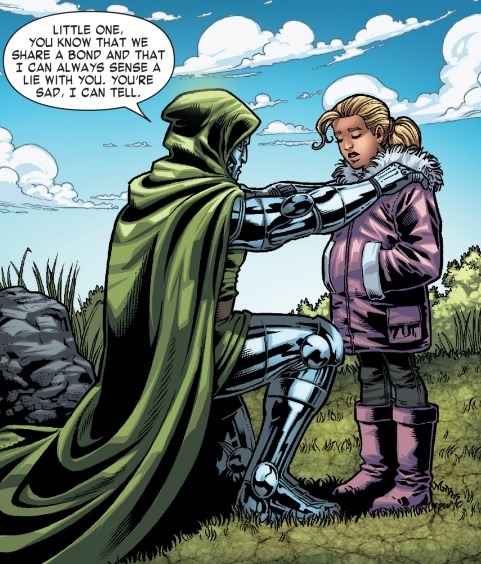
(Fantastic Four v5 #5)

(FF (2011) #13)

(Fantastic Four #611)
The story of Val and Doom’s relationship cuts two ways, and is a little complicated to explain from the beginning. First, we have to talk about the nature of Valeria’s birth in canon. Way back in Byrne’s run, Sue and Reed conceived a child while on a trip in a Negative Zone, because that was a real smart thing to do. Sue’s previous pregnancy with Franklin had been very complicated towards the end, nearly resulting in the death of both her and Franklin. Her second pregnancy also proved very difficult and in Fantastic Four #267 she suffered a miscarriage late in her pregnancy. Fast forward a couple of years to Claremont’s run, where a teenage girl claiming to be the daughter of Sue appears before the Fantastic Four. She further claims to be time traveling from a future where Sue would marry and have a child with Doctor Doom:

(Fantastic Four v3 #21) This teenaged incarnation is actually the very first appearance of Valeria Richards, though here she goes by Valeria Von Doom. This arc is a little, should we say, complicated, and to compress things greatly I will say it’s very possible that the “Doom” of the future who is this Valeria’s father might very well be Reed in Doom’s armor, since that’s a big part of Claremont’s run. Never the less, this Val considers Doom her father and addresses the real Doom as such, leading to a fairly hilarious custody dispute:

(Fantastic Four v3 #25)
It turns out that this Val is actually the transported soul of the baby Sue lost, who was saved by Franklin with his reality warping powers and stashed in an alternate dimension where she grew up safely. In the process of defeating the villain Abraxis and bringing Galactus back, Franklin, and there’s truly no good way to say this, uses his powers to make Sue pregnant again with the same baby. This is the Valeria we know in current canon. But again, Sue’s pregnancies have always been very complicated, and that holds true as she goes into labor with Valeria… again. With Reed held captive and unable to help, Johnny enlists the assistance of the only other person he can think of who would be smart enough to save both Sue and the baby: Doom.

(Fantastic Four v3 #54)
Doom delivers the baby on the condition that he’s allowed to name her. Sue agrees and he names her Valeria after his childhood love. (The death certificate of the original baby Sue lost lists her name as Megan Valerie Richards, for the record.) He places baby Val under his royal protection and since then has displayed a particular fondness for her. After Fraction’s Fantastic Four run and during the bulk of Robinson’s, she even lived with him in Latveria.

(Loki: Agent of Asgard #7)
I think at this point it’s really the individual writer’s choice where Doom goes in relation to the rest of the Fantastic Four, but I have to say, I’m in favor of the “vaguely murderous uncle shows up to maybe ruin Thanksgiving” take that’s been cropping up on and off the past few couple of years. Doom and Reed have long been painted as two sides of the same coin and Reed is very deeply rooted in Doom’s origin; meanwhile, in Marvel Two-In-One, Doom seemed to express actual care about what happened to Ben and Johnny. Slott’s run seems to have hit the reset button on all of that, but if you want some good “Doom, part of the family” content, I really recommend Hickman’s run on both Fantastic Four and FF, and Robinson’s run on Fantastic Four.
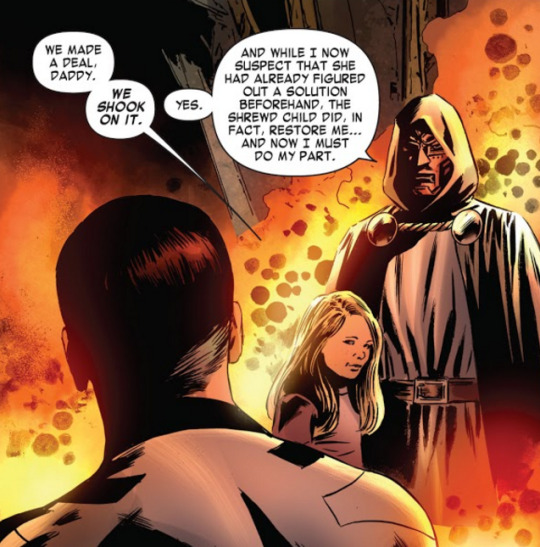
(FF (2011) #2)
88 notes
·
View notes
Text
favorite (superhero) comics issues (serious edition)
I was just thinking about this the other day and decided for no particular reason to go and make a list of some of my favorite single issues of various comics (limiting it to five because that’s manageable). I ended up making two sets, one for the serious/moving stuff that blows me away, and one for the absolutely batshit ridiculous stuff. Because comics can do both really well.
I confined it to superhero comics, again for the purpose of limiting the field, and this is far from an exhaustive list. Some others I could have included are: X-23 #20, Agent of Asgard #13, Infinity Gauntlet #4, Ms. Marvel #17, All New Wolverine #18, Captain America #332, X-23 #1.
1. Agent of Asgard #17.
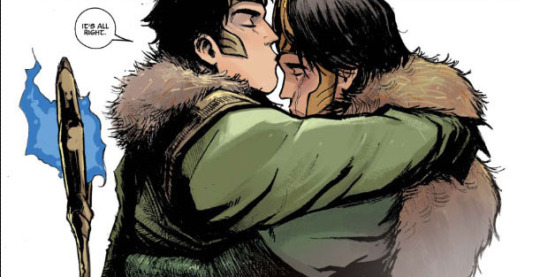
I’ve talked a lot about my feelings on this one, but there are a lot of feelings. Just...the themes of self-forgiveness and freedom of choice, the level of meta, the beautiful closing of Loki’s arc that began in Siege: Loki and carried through Journey Into Mystery and Young Avengers...and finally comes here. Just...it’s a beautiful piece of work and it makes me emotional every time.
2. Journey Into Mystery #645.

Speaking of emotional, on the other end of things this is the issue that rips my entire goddamn heart out. Kieron Gillen’s whole run is gorgeous, and it all leads here, to this beautiful, painful, conclusion - it has so much to say, as I’ve discussed, about the way that superhero comics work, and the way that characters in superhero comics work, and Stephanie Hans’ artwork makes the whole thing all that much more beautiful and agonizing. It’s lovely. It hurts so much. I cry literally every time.
3. Animal Man #26

Full disclosure - I have not read any Animal Man other than this issue, but god, this issue. Comics are a really fun place to play around with metanarrative and stories about stories, and they do it really well, from She-Hulk to Agent of Asgard to - yes - Animal Man. This is the issue where Grant Morrison and Animal Man have a conversation, and it’s basically all about comics, and the interface between real life and comics, and a character confronting a creator about what they’ve done - in this case, the death of Animal Man’s family. And just...the whole thing is beautiful, and super cool for the meta aspects, but it’s this part of the conversation that hits me hard every time.
“Maybe, for once, we could try to be kind.”
4. Black Widow #5.

AKA the one where Black Widow walks out of a refrigerator. I wrote an essay about this one and how Marjorie Liu plays with common tropes about women and power, and how this issue puts Natasha naked in a literal refrigerator and somehow manages to give her all the power and - thanks to Daniel Acuna’s art - not sexualize her. She turns the tables in the most glorious ways, and walks out under her own power. There’s so many interesting dynamics at play. I love Marjorie Liu’s whole run on this series but this issue in particular stands out for what it’s doing with tropes about women in comics.
5. X-23 #16

This issue is weird, and most of it is actually very much out of my wheelhouse as having to do with the Fantastic Four and a corner of comics I knew nothing about (Captain Universe) but it earns a place on my list for the line that sticks with me always and forever: “I do not need to touch them. I am made of stars.”
HOLY SHIT YOU GUYS
52 notes
·
View notes
Note
any lengthy, luxurious loki/reader or oc fics to rec from ao3 ??? I have so much need
Hi! omg thank you for the ask!!! I absolutely have some recs! I’m a little unsure about whether or not they’re “luxurious” but I enjoyed them! I had to go back through my reading history on ao3 to find all the fics that need to be shared, so if you’ve already read them - sorry! I tried to give you the fic summaries and my brief summary about why I liked the fics. I hope you enjoy them as much as I did!
Currently reading: The Sound of Silence (A mute Enhanced and Loki both move in to the Avengers tower on the same day.) I do like this one and it is 89k words. My only hesitation is that the “reader” character is supposed to be a sophomore/junior in high school (from what I understand having read 13 chapters so far) and I’m slightly uncomfortable reading the intimate exchanges with a teenager. But it’s well written and very self-indulgent, so I would recommend it!
HIGHLY RECOMMENDED: The Seeming & The Real (You work as Pepper Pott’s assistant and have a crush on a certain demigod. More than convinced that said crush is simply absurd, you’re more than a little flustered when finding out that your feelings do not seem all that much unwelcome.) 21k, I fucking loved this one. Angst, hurt/comfort... Ugh, it was so good. I think if I was going to call a fic luxurious, it would probably be this one because it was just... everything I like in fics.
HIGHLY RECOMMENDED: Appointment with Loki (In need of a dress for your cousins weddings, you end up in the fitting room of one Loki Laufeyson, dress designer to the high society. You are not prepared at all for the way he moves, the way his green eyes watch you, or the way he says "please" in that deep dark voice before he touches you. By the end of the first appointment, you have given into his charm. By the end of the second, you might be addicted to him. As the days go by, you spend more and more time in his arms, you fall farther and farther in love. But then summer ends and its time for you to go. But is your heart the only one broken, or have you destroyed Loki as well?) 24K, everyone’s human, Loki is a tailor and you need a bridesmaid’s dress. Damn, the self-indulgence in this one. This one is heavy on the smut and absolutely earns the “explicit” rating, but it is so so so good.
HIGHLY RECOMMENDED: The Agent Earth Series (Loki's punishment for his attempted takeover of New York is to remain on Midgard without his magic until he has learned the consequences of his actions. (Y/N), being the now second-newest Avenger, decides to make a friend. Both she and Loki are new to such a concept. Feelings develop, but soon afterward, as with nearly all relationships, all hell breaks loose. Their time together is in grave danger of being cut short, but (Y/N) has a family, and Loki has a plan.) 25k for the whole series, well written, you’re a member of the Avengers.
HIGHLY RECOMMENDED:The Light in the Dark (Imagine being blinded in an accident while helping S.H.I.E.L.D., you live in the Tower with everyone but dread the way they treat you like a helpless child. When Loki arrives on Midgard to carry out the rest of his sentence he becomes curious with your condition and how you manage to read and such. Over the months the two of you grow closer than the others thought possible. You come to love him without ever seeing him. Imagine Loki pleading with Thor to allow him back to Asgard for only a moment to retrieve a spell book that would help him return your sight so you could see once more. When he disappears for a period of time you grow worried that he will not return, but when he does, he gives you the greatest gift you could have ever hoped for. Your sight.) 61k, angst, hurt/comfort, fluff, you’re not exactly an Avenger but you work with the team as a scientist. So I really liked this one. It was a smooth read because there wasn’t a lot of “Y/N” inserted throughout the story. Also, this was the first Loki x reader fic I ever read and I feel like it was a good introduction to the genre.
Locked Up (After Loki fell from the Bifrost, you, his wife, get locked up in fear of retribution. What will you do when Loki returns and neither of you are the same?) 12K, you’re an Asgardian.
I Didn’t Mean It (Loki takes refuge at your home as he's on the run from Thor.) 7k, you’re a loner living in the woods on Earth and friends with Tony Stark’s new wife, also an OC. Oh, and you own an iguana.
The Old Meets The New (Loki is up to his usual antics, but then your ex husband approaches the two of you and Loki finds out that you're more scared of your ex than you are of him. When he discovers why, things get messy.) 7k, hurt/comfort, you’re a member of the Avengers.
Ex-Villian, New-Lover (Reader is a part of Avengers. But she wasn't around while New York Battle so she hasn't meet Loki. One day Thor returns from Asgard with Loki and both Reader and Loki are falling hard for each other. Of course it will be a little hard for them because you know Avengers are over protective.) 16k, you’re a member of the Avengers and best friends with Bucky Barnes.
Revelations (This is a slow-building piece about you and Loki. Your father (the king of a small village) sells you to Odin to be a wife for Loki in exchange for getting your small kingdom out of debt. You are obviously not pleased to be sold or uprooted from your home. At first, you and Loki want nothing to do with each other... But soon, revelations take place on both ends that have you questioning what you originally felt for each other.) 66k, you’re a princess, slow burn.
I Love To Hate You (Alexandra is the future queen of Vanaheim and her mother is a close friend of Frigga, so when she and her family come to Asgard for a visit, it is noted how she will require a capable husband by her side for her reign, but Prince Thor is to rule Asgard, leaving Prince Loki as the only possible suitor in the house of Odin, there is only one issue, Alexandra and Loki hate one another. As the years go by, it does not get any better, and when the are wed, they are amiable at their best and still bickering incessantly. How can the rule a realm, much less consider raising an heir together?) 29k, OC character instead of reader-insert, slow burn.
What We Leave Behind (Imagine finding out you’re pregnant after Loki has fallen off of the Bifrost. Out of fear of retaliation from Odin, you only confide in Frigga, who helps you to escape the palace and have the baby in secret. When Loki is the cells of Asgard, you sneak in and introduce your daughter to him.) 11k, established relationship, angsty, you’re Asgardian and pregnant w/Loki’s child. I liked this one because the author didn’t have “Y/N” throughout the fic so it was a very smooth read.
5 notes
·
View notes
Text
Shared Beer & Secrets
read it on the AO3 at https://ift.tt/3Bzhp8m
by Sand3
“... Tell me I’m pretty,” Loki said.
“You damn well know you’re pretty,” Fandral whispered.
“The only nice thing anybody ever had to say about me,” Loki sighed, and then pulled back a little to put his forehead against Fandral’s. “But I asked you to tell me.”
“It isn’t ‘nice’ when they call you clever?” Fandral countered. “You’re pretty.”
“They don’t mean it to be nice. One doesn’t like the viper in the nest to be clever,” Loki said, bringing his mouth close to Fandral’s, lips brushing on the last word, then teasingly pulling back an inch. “How pretty?”
** Takes place right after YA issue 13.
Words: 7521, Chapters: 1/1, Language: English
Fandoms: Thor (Comics), Loki: Agent of Asgard, Young Avengers (Comics)
Rating: Mature
Warnings: No Archive Warnings Apply
Categories: M/M
Characters: Fandral (Marvel), Loki (Marvel), Loki (Agent of Asgard)
Relationships: Fandral/Loki (Marvel)
Additional Tags: Angst-rotica, trashy purple prose sex
read it on the AO3 at https://ift.tt/3Bzhp8m
0 notes